Boxes and Quality Inspection Stamps
BOXES AND QUALITY INSPECTION STAMPS
Greetings all!
As collectors of Dinky Toys, we all know, or have come to learn just how expensive mint models are and especially when the model is packaged in its original box. As a matter of fact, it is hard to comprehend, that a small piece of cardboard represents about 43% of the value of a mint and boxed model. How many of us in the 1950s and 1960s did not really understand or appreciate the true value of the box? Fortunately, many of my Dinky Toys from those carefree days still have their boxes, albeit somewhat worn and in several cases, no end flaps but the pieces of glued cardboard have survived a decade or more of solid and carefree play!
TWO OF MY SMALLER MODELS IN THEIR ORIGINAL BOXES
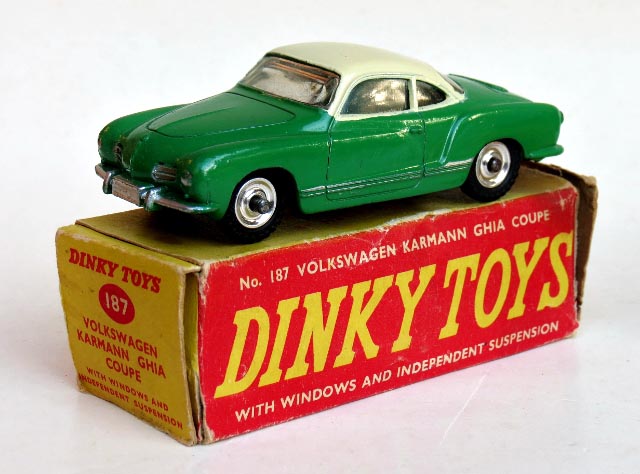
With my Karmann Ghia, the box has the original price my parents paid for it which was 6/5 (six shillings and five pence), which was the price when the model arrived in Australia in 1959 until February 1961 when it increased to 6/9. I know I received it as a Christmas present, but which Christmas?

The box shows the Australian price of 9/- a price that remained constant throughout 1962 and 1963. I received this model for Christmas 1962. It was one of the last Dinky Toys I received for either Christmas or birthdays. (Like so many of my Dinky Toys this one too has been subjected to excessive play by some unknown urchin after I left home! Readers will see more references to this urchin further on this Post!)
With such a value for good boxes, it is no wonder that mint and boxed models are out of reach of the average collector. It is also no wonder that a seller of an unboxed model, will add a box procured from elsewhere to the sale to increase the final amount. It is also understandable, but infuriating, when an eBay seller, auctions the model and box separately. What has remained as a single unit, model and its box for many decades is broken up for the sake of making more money. Fortunately there are still a number of collectors who have bought separated models and boxes, thus keeping them together as a single unit.
With the value that cardboard adds to the final price it is not surprising therefore that a seller will go to extra-ordinary lengths to obtain any original box, just as long as the picture on the box matches the model. But then, the seller is embarking on a deception when in many cases, the box is not the type or style in which the model was originally packaged. For instance, if a collector has bought an excellent 182 Porsche 356A Coupe in red, or cerise, it is important to know that the boxes for either of these is in lighter yellow, with the drawing of the model on both sides in very pale cream.
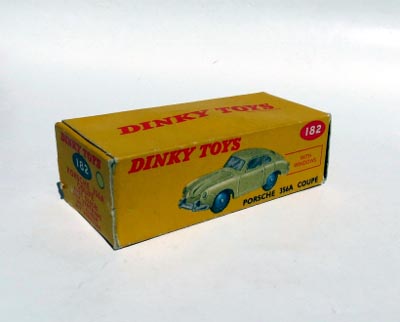
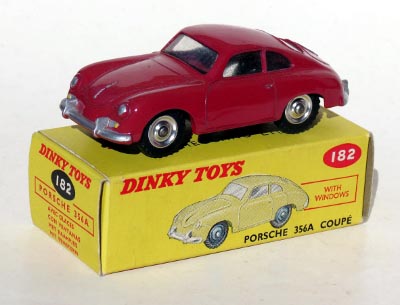
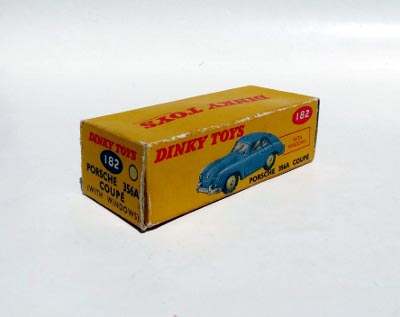

The yellow lidded box with a dark blue base that was used for both larger Dinky Toys creates many problems for collectors. If the printing is in block, these together with their models came down the conveyor belt in Meccano during 1956. Later issues when the model itself was downgraded from Supertoys to just Toys, the yellow lidded boxes were given italic lettering for DINKY TOYS. For a larger model, say the 660 Tank Transporter with windows, the correct box is blue striped with italic writing for DINKY SUPERTOYS. I will explain the numerals that can be found on most yellow lidded boxes for the Tank Transporter, mainly for the benefit of an ignorant cataloguer in the north later in this post.
The purpose of this Thread is to help Dinky Toys collectors recognise when a model does not match the box, to ensure that the money he/she outlays results in the purchase of a boxed model that is for all intents and purposes totally genuine both model and box and that the collector has not been ripped- off.
And this is where we come to the Quality Inspection rubber stamps.
For quite some time now, readers of this Forum have encountered numerous references to QC numbers, or Quality Check (Inspection) Numbers in the boxes for the larger Dinky Toys and Dinky Supertoys. These are the peculiar rubber stampings that can be found on the inside of most box lids, blue covered with an orange, white and black label, or blue striped on a white background or on the base of yellow trade boxes, early dark blue base boxes and orange boxes with or without a printed label. Sometimes the stamp is clear and legible and at other times, it is very faint, but if care is taken most stamps can be read. (In fact, photographing these stamps with a digital camera, and depending on the photo-shop used, what originally appears illegible can be brought out clearer – I have used this method many times.
For the past 15 years, I have been recording these stamps, either from boxes that have come into my possession or friends have checked their boxed models and advised me of the details, or details that have been included in an auction description or enquiries to auction houses or eBay sellers. I came to realise very early on, that these innocuous little stamps conveyed a very special message, although at times it has proven rather difficult to learn exactly what that message was. Some numbers appear to be missing, and in numerous cases it has been a case of “gestimating†as to what the stamp relates. Even the letters at times are strange. These stamps have been applied in the factory, and although we do not know for certain what the purpose was, the majority of collectors interested in these stamps consider that they are in fact Quality Inspection Stamps which are applied to the box by the individual packing the models as an indication that the model is complete, has no obvious defects and that the model is leaving the factory in a sound, saleable condition. At first I thought the letters that form part of the stamp, and these can be found either before or after the numerals, were the initials of the ‘â€inspector†the person examining the model, until I started to find numerous initials with X and Z. If the letters are the initials of the checker, those with an X or Z may in fact have had an identical set of initials as someone else checking the models at the same time, so the duplicate was given a letter X or Z to replace one of the identical letters.
However, what is very much of interest are the numerals. From these, we can, over a period of time, come to learn the months when certain models rolled down the conveyor belts at Binns Road. Take for instance the following model.
It is a near mint and boxed 513 Guy Flat Truck with Tailboard.
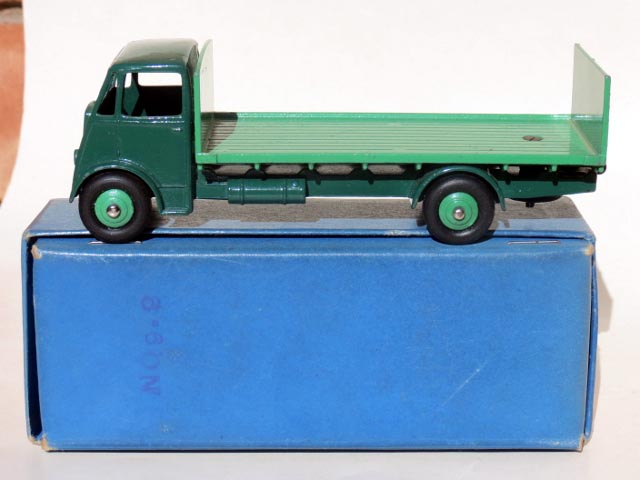
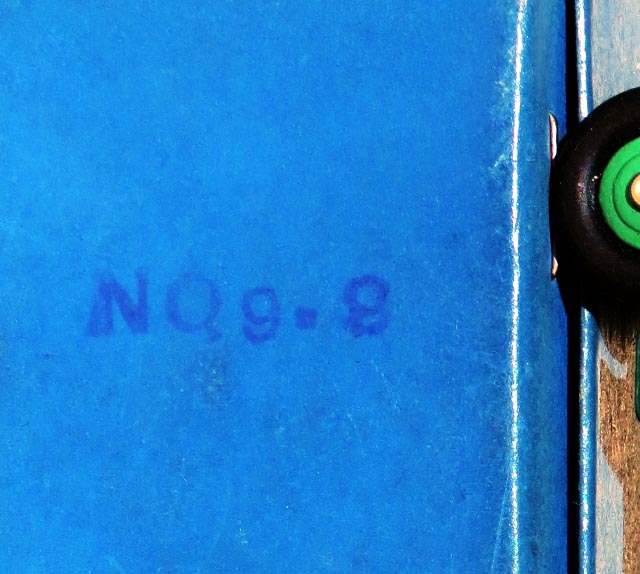
The above images are of the inspection stamp on the bottom of the box base that housed this model. In analysing the stamp, it appears to state NQ 9.8. That would normally read NQ September 1948, except for one thing. The numeral 8 is inverted. As these stamps are made up in the factory using rubber inserts, it is very easy to be confused with how the numeral 8 should be inserted into the block. Confusion can then arise especially on looking at the made-up stamp, one has to visualise it in a mirror fashion. The original price is an added bonus that in most cases can confirm the presumed data with the QC stamp.
In the case of this boxed Guy there is and it states 4/3, four shillings and threepence. Assuming one decides that the stamp is for June or September 1948, then the price on the box should be one applicable to the vicinity of those dates. In 1948 the price for the 513 was 7/6. However, if we assume the date is August 1949, the price from April 1949 was 4/-, but by February 1950 the price was in fact 4/3 so between April 1949 and January 1950 there had been a price increase, making the date most likely August 1949.


With this 514 Guy Van “Slumberlandâ€, the Quality Inspection stamp shows nQ3.5. This could be translated to read “nQ March 1955â€, but this is incorrect. The price on the box is 5/11. This price was applicable between February and August 1950.
The Guy Van “Slumberland†was released in December 1949 with a price tag of 5/8. The Meccano Magazine for January 1950 does not display any prices for the Dinky Toys and Supertoys in the two page advertisements. Nor are prices shown in the February issue, but in March the price became 5/11. The February 1950 Meccano price leaflet that includes Dinky Toys and Dinky Supertoys shows the price as being 5/11. So that sorts out the “3†in the stamp. But what about the “5â€? Could this be 1955 and the answer is no, as this model was replaced by the “Lyons†van in November 1951. The obvious answer is the “0†in “50†had been dropped making this model a March 1950 production example. Fascinating stuff, eh?? I can hear the response, “yeah, if you are into this sort of stuff but really boring!â€
923 Big Bedford Van “Heinzâ€
To provide an example on how useful the Inspection Stamp data can be, (at least to those who might find it fascinating!) at some point, the 923 Big Bedford “Heinz†was issued in a plain blue striped box. As far as I am aware, no dates exist in published sources as to when this took place.
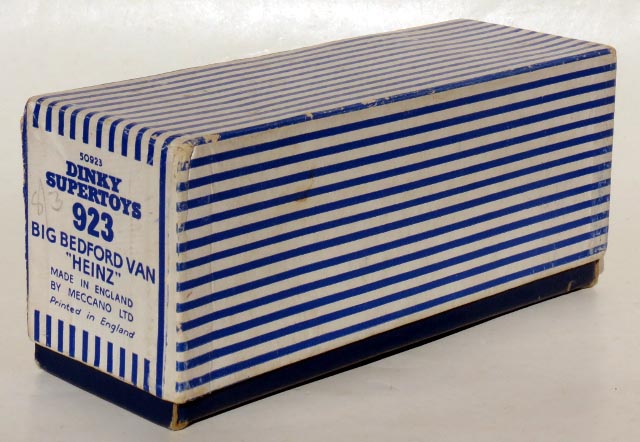
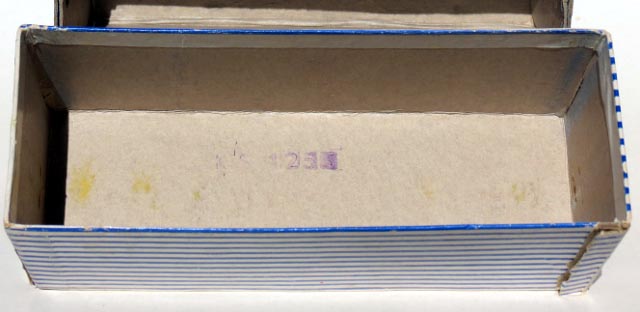
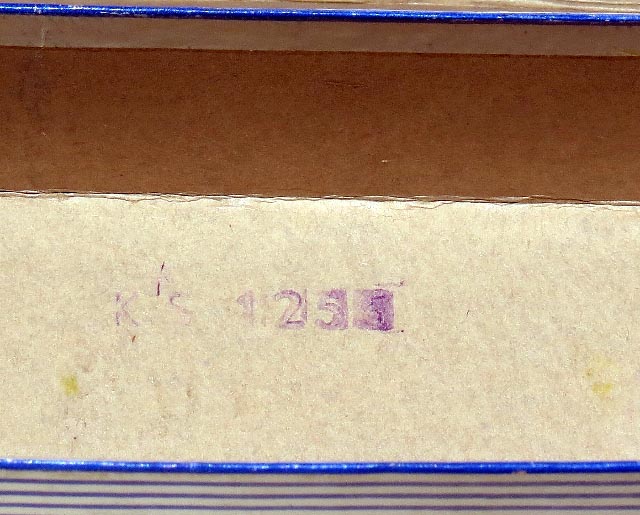
However, the inspection stamp shows this box K S 1255 (and no doubt many, many others at the same time) was produced during December 1955. The price written on the box confirms the Quality Inspection stamp. Did Meccano under-estimate the number of boxes to order and to fill the gap, which resulted in Meccano ordering a quick, single colour replacement? Possibly Christmas 1955 was a real boom for this model with its colourful painting and authentic transfers? This was not the first time the plain blue striped box was used. In November 1958 during the sauce bottle production, the same box style was used. Was this also a case of the booming Christmas sales now that a sauce bottle had replaced the baked beans can? In the case of the Can model was it decided not to have any artwork as Meccano may already have had plans on replacing the transfer from can to sauce bottle, and if so, was this at the request of Heinz? So the question arises, was the plain box in use for more than a single month in both cases, and were both cases linked – a large quantity had been received in 1955, then the surplus was put to one side for future use after the new stock of the pictorial box had been received? These surplus boxes were then put to good use three years later. A possibility??
The stamp data I have collected shows the 923 Big Bedford Van “Heinz†was in actual production during the following months:
November and December 1955, February 1956 and March 1957 (with the Baked Beans Can with the DINKY SUPERTOYS printing style changing to italic DINKY SUPERTOYS during March 1957 with both block and italic being in use during the same month.)
March and April 1958, November 1958, January 1959 and May 1961. The last box is interesting. The box contains a sauce bottle version, but the box is in block lettering and has a picture of the can version with the quality stamp being KR 561. This is an example of where a box does not match the contents. It was sold through eBay. In all probability, the stamp should read KR 156 – the person preparing the stamp inserted the rubber numerals as she looked at it, rather than using a mirror to see how the stamp will appear in the box.
The 923 last appeared in print for the UK in January 1960 so it would be interesting to learn the month when the model last rolled down the Meccano conveyor belt, or was January 1959 its swan song with sufficient stock on hand for the model to be retained in print, either catalogue or price list, for a further 12 months? Hopefully, members of the DTCA as well as collectors elsewhere may be able to provide details on the boxes in their possession.
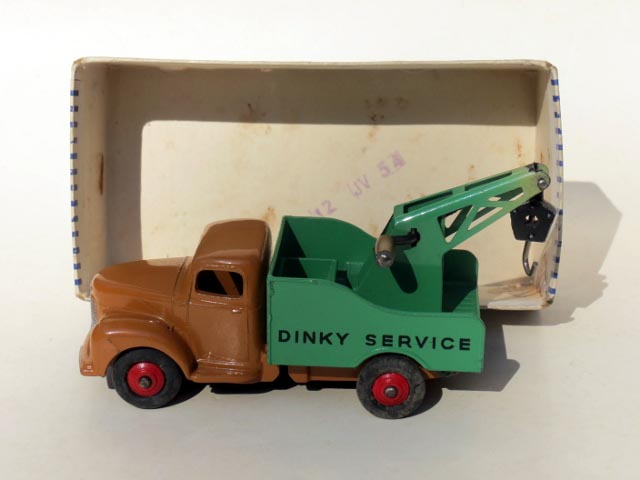
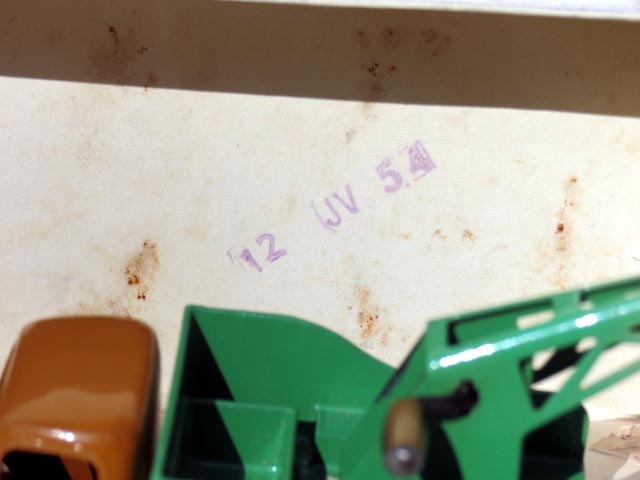
The above is a 430 in mid brown, green back, red hubs and black lettering, made during December 1954. This stamp is interesting as it was used many times with changes, two numerals a large space then two letters, followed by another large space and two more numerals.
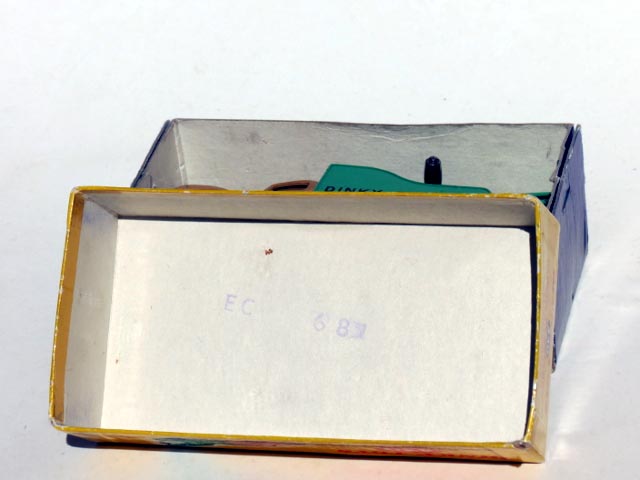
The above is one of the first yellow-lidded boxes with DINKY TOYS in italic. The stamp reads June 1958.
According to the stamped data for the 25x/430 Breakdown Lorry that I have gathered, the model came off the production line during the following months:
25X
January, August 1950 (all plain orange boxes)
August 1950 (the start of orange boxes with applied label)
February 1951
January, March, April, May 1953
February 1953 (the start of blue striped boxes), June and October 1953
430
May August and December 1954
January, February, May, July, August and September 1955
January, February, March, September and October 1956 (September 1956 is the first I have of the yellow lidded box with block lettering)
(In March 1956, one of the colours of the model was deep cream cab-chassis, blue back, black lettering, red RW)
February, April and December 1957 (all models found thus far were in light tan, green back, red RW)
January 1958 (The last of the yellow lidded boxes with block printing for DINKY TOYS)
June 1958 (the start of known Italic printing for DINKY TOYS)
March 1959
January and December 1960 (December 1960 had windows)
December 1961 (Light tan, green back, black lettering, treaded tyres red RW)
After this date, Meccano appears to have dispensed with quality checking although I have found occasional boxes with stamps for 1962, 1963 and one for 1964.
Perhaps more data from collectors can fill in the gaps for the Commer or even correct some of the details included in this Thread.
419 LEYLAND CEMENT WAGON “PORTLANDâ€
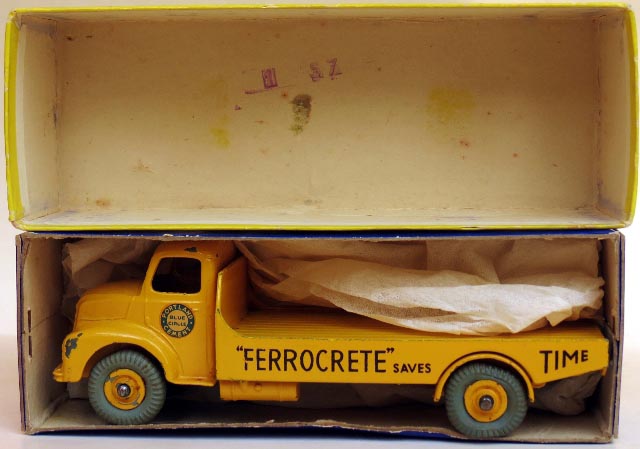
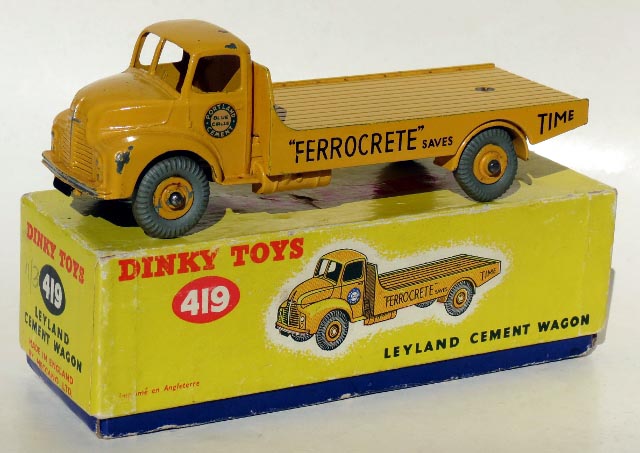
The above Leyland Cement Wagon has the Quality Inspection stamp of just numerals, 1 57, which translates to be January 1957. The price on the box end written in pencil has 11/3, the Australian price for this model is from at least April 1956. Prior to this date, the price was 10/3. I can guarantee that the box and model have never been separated – I was given the Leyland for Christmas 1957 – one of my favourites which remained totally mint until I left home in 1964 and some urchin was allowed to “play†with it!
901 FODEN DIESEL 8-WHEEL WAGON
Another example where the Quality Inspection stamp is confirmed by the original price:
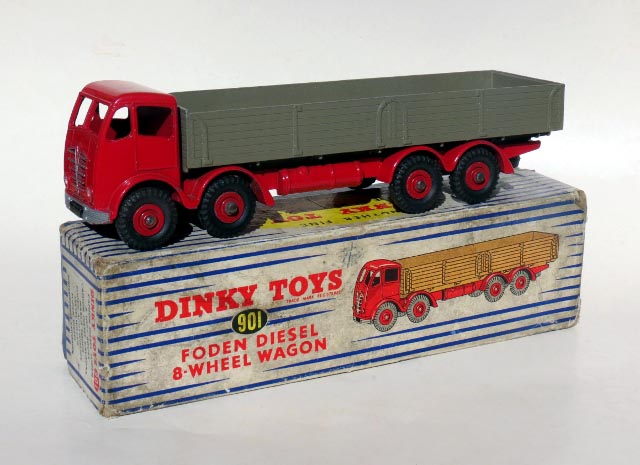
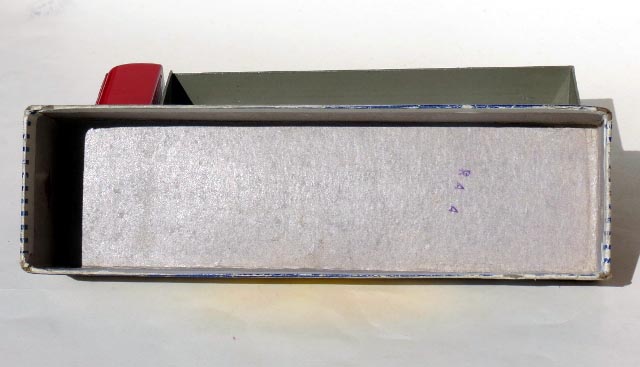
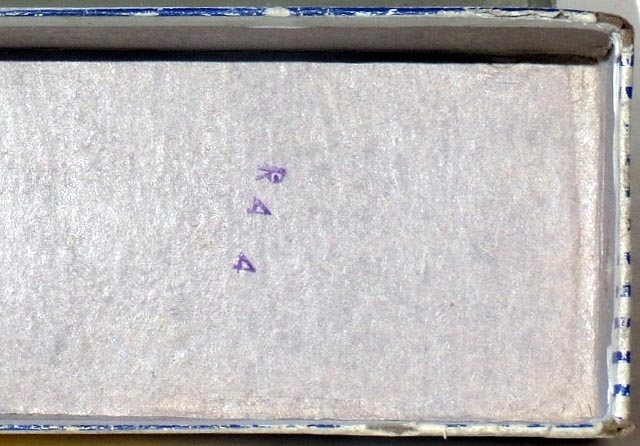
This 901 Foden Diesel 8-Wheel Wagon has the inner stamp of R 4 4, which translates to April 1954. The box has its original price of 7/6 – a price applicable to April 1954.
From details of a number of quality Inspection stamps, we now know that the 501 Foden 2nd Cab was being manufactured during,
April, July, August and October 1953 (dark blue covered box, DINKY TOYS with an orange-white wrap-around label)
Between April and August 1953, I have only found models painted dark blue cab-chassis and light blue back, with the red and fawn version appearing for the first time in October 1953. Collectors reading this Thread may be able to add or correct these details.
And as the 901 Foden Diesel 8-Wheel Wagon in,
April and May 1954 (Blue striped DINKY TOYS box from now on)
The Dark Blue cab-chassis and light blue back was produced at least during May 1954
January, February, March, May and November 1955
(No data is held on production, if any, between December 1955 and April 1956
May, June, August, September and October 1956 (From August 1956, the box is now inscribed DINKY SUPERTOYS in block lettering
February and April 1957
905 FODEN FLAT TRUCK with CHAINS
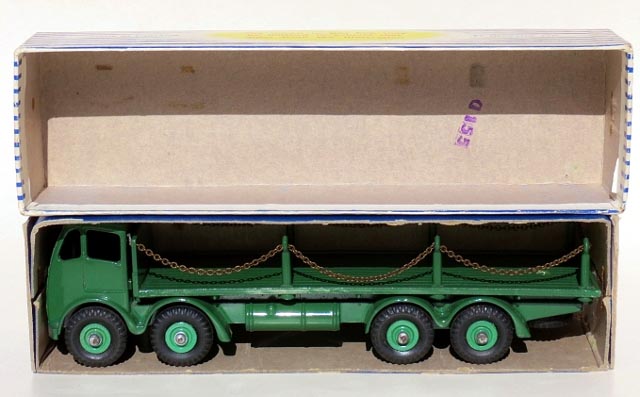
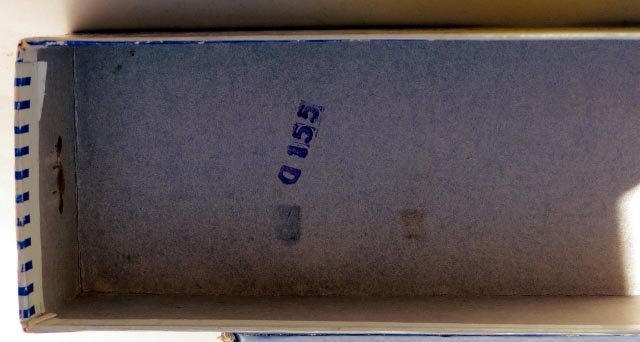
This model came down the Meccano conveyor belts in January 1955. Note that the letter “D†is back to front.
From details of a number of quality Inspection stamps, we now know that the 905 Foden was being manufactured during,
May and June 1953 as a 505 in a dark blue covered box with an orange and white wrap-around label painted in maroon cab-chassis and back as well as ST grooved hubs. In May 1953, the model was shod with grey tyres.
April and October 1954 (April in mid green and October in Maroon)
January, February, March and August 1955
March, April, May, June, July 1956
(No production data is held from August 1956 to October 1961. Hopefully this will be corrected in the time ahead.)
November 1961, the box is now DINKY SUPERTOYS in italics with the model in red with grey back and ST hubs.
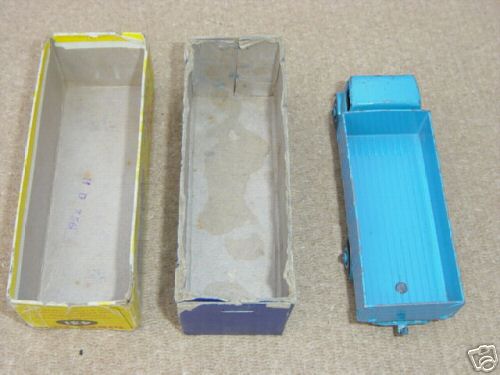
Borrowed from eBay, the stamp data provides collectors with a date when the above very uncommon all light blue 431 GUY 4-TON LORRY was issued – July 1956 with a Quality Inspection Stamp of HD 756. Another boxed model in the same colour scheme has also been located with the Quality Inspection Stamp of N 0 6 56 which indicates this rare version was in production for at least two months. If more box data stamps can be located, this would then show collectors the length of period this colour scheme was actually in production although this does not show the quantity produced in each month. The month before, production of the 431 saw them in the usual dark blue cab-chassis and light blue back.
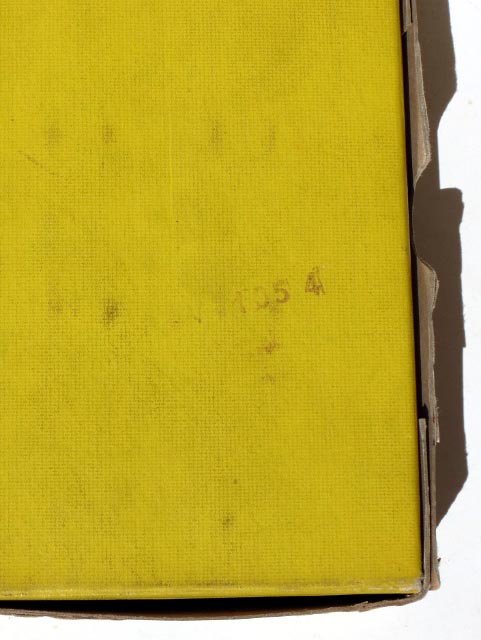
The stamp on the underneath of the above Trade Box shows its contents, six 480 Bedford CA “Kodak†vans came off the line in October 1954, four months after production had started. Were the original models from June 1954 only available from a Trade Box or was there a mixture of Trade Boxes and individual yellow end-flap boxes?
Six Months Sample of Data extracted from Inspection Stamps
With the above tantalising details that can be found on most lidded boxes, let us now turn our attention to the year of 1956 – a year in which each of the above models were in production. Here are the production types for the first six months of 1956 from the limited information I have collected over the years:
January
408 Big Bedford Lorry Deep blue, yellow back and ST hubs
408 Big Bedford Lorry Maroon, tan back, light tan ST hubs
418 Leyland Comet with hinged tail board Green, orange back, mid green ST hubs
430 Commer Breakdown Lorry Light tan, green back, red hubs
651 Centurion Tank Military green
771 International Road Signs
942 Foden Tanker “Regent†Dark blue, red and white
963 Blaw Knox Heavy Tractor Red, black wheels
965 Euclid Rear Dump Truck Pale yellow
972 20 Ton Lorry Mounted Crane Orange, deep yellow
February
418 Leyland Comet with hinged tail board Green, orange back, mid green ST hubs
430 Commer Breakdown Lorry Light tan, green back, red hubs
622 10-Ton Army Truck Military green
651 Centurion Tank Military green
732 Gloster Meteor Silver
942 Foden Tanker “Regent†Dark blue, red and white
962 Dumper Truck Deep yellow
902 Foden Flat Truck Orange, green
905 Foden Flat Truck with Chains Green, light green ST hubs
918 Guy Van “Ever Ready†Mid to Dark blue, red ST hubs
923 Big Bedford Van “Heinz†Red, yellow
933 Leyland Comet Cement Wagon Yellow, black
934 Leyland Octopus Wagon Yellow, green cab band and back, red ST hubs
965 Euclid Rear Dump Truck Pale yellow
982 Pullmore Car Transporter Mid blue, light blue, fawn decks
991 AEC Tanker “Shell Chemicals†Red, yellow
March
401 Coventry Climax Fork Lift Truck Orange, green
409* Bedford Articulated Lorry Deep yellow, black
430 Commer Breakdown Lorry Deep Cream, blue back, red RW
432 Guy Flat Truck Mid blue, red flatbed, mid blue ST hubs
622 10-Ton Army Truck Military green
903 Foden Flat Truck with Tailboard Dark blue, orange, mid blue ST hubs
905 Foden Flat Truck with Chains Maroon, red ST hubs
905 Foden Flat Truck with Chains Green, light green ST hubs
918 Guy Van “Ever Ready†Mid to Dark blue, red ST hubs
921* Bedford Articulated Lorry Deep yellow, black
934 Leyland Octopus Wagon Yellow, green cab band and back, red ST hubs
981 Horse Box Maroon, maroon ST hubs
982 Pullmore Car Transporter Mid blue, light blue, fawn decks
*See comment below
April
409 Bedford Articulated Lorry Deep yellow, black
622 10-Ton Army Truck Military green
651 Centurion Tank Military green
660 Tank Transporter Military green
905 Foden Flat Truck with Chains Green, light green ST hubs
905 Foden Flat Truck with Chains Maroon, red ST hubs
905 Foden Flat Truck with Chains Maroon, cream ST hubs
934 Leyland Octopus Wagon Yellow, green cab band and back, red ST hubs
942 Foden Tanker “Regent†Dark blue, red and white
971 Coles Mobile Crane Deep yellow, black yellow ST hubs
972 20 Ton Lorry Mounted Crane Orange, deep yellow
981 Horse Box Maroon, maroon ST hubs
May
408 Big Bedford Lorry Deep blue, yellow back and ST hubs
408 Big Bedford Lorry Maroon, tan back, light tan ST hubs
431 Guy 4-Ton Lorry Dark Blue, blue back and ST hubs
433 Guy Flat Truck with Tailboard Blue, orange back, mid blue ST hubs
660 Tank Transporter Military green DINKY TOYS under trailer
660 Tank Transporter Military green DINKY SUPERTOYS under trailer
699 Military Vehicles Set Military green
901 Foden Diesel 8- Wheel Wagon Red cab-chassis, fawn back, red ST hubs, block tyres
902 Foden Flat Truck Yellow cab-chassis, green back and ST hubs
902 Foden Flat Truck Orange cab-chassis, green back and ST hubs
905 Foden Flat Truck with Chains Green, light green ST hubs
934 Leyland Octopus Wagon Yellow, green cab band and back, red ST hubs
982 Pullmore Car Transporter Mid blue, light blue, fawn decks with ramp
991 AEC Tanker “Shell Chemicals Limited†Red, yellow
June
431 Guy 4-Ton Lorry Light Blue cab-chassis and ST hubs
432 Guy Flat Truck Mid blue, red flatbed, mid blue ST hubs
417 Leyland Comet Lorry Violet blue, yellow back, red ST hubs
651 Centurion Tank Military green
660 Tank Transporter Military green DINKY SUPERTOYS under trailer
697 25-Pounder Field Gun Set Military green
901 Foden Diesel 8-Wheel Wagon Red cab-chassis, fawn back, red ST hubs, block tyres
905 Foden Flat Truck with Chains Green, light green ST hubs
905 Foden Flat Truck with Chains Maroon, red ST hubs
934 Leyland Octopus Wagon Yellow, green cab band and back, red ST hubs
991 AEC Tanker “Shell Chemicals Limited†Red, yellow
771 International Road Signs
980 Horse Box Maroon, red ST hubs, inscribed HORSE-BOX on base
From the above, we can see the models that were obviously popular such as the 905 and 934 that were both in production from February to June 1956, 651 produced in four of the six months, 430 during the first three months, and the 660 from April to June. One thing noted is in March – the month saw the Bedford Articulated Lorry being packaged in both the old 921 box as well as the updated 409 box.
The Smaller Dinky Toys
I started this Thread by writing about boxes for the smaller Dinky Toys, cars, commercials, military, emergency, etc and the trap that an unsuspecting buyer can fall into. I then discussed the Quality Inspection Stamps that can be found on most larger Dinky Toys/Dinky Supertoys in lidded boxes. But we should not at the same time forget about the smaller yellow end-flap boxes, as it is quite surprising to realise that these too were subjected to a quality Inspection although not to the same consistency as the lidded boxes. The vast majority of these “Quality Inspection†stamps in the small yellow end-flap boxes were of a different style to that used for the larger lidded boxes and the practice of using these stamps appears to have ceased at about the same time as those on the lidded boxes were stopped. These consisted of three rows of numbers, each row having three numbers. It is interesting that this style also appears frequently with the larger lidded boxes, so it is possible that the individual examining the small Dinky Toys, may have at times checked the larger boxes, using the same stamp as for the smaller boxes.
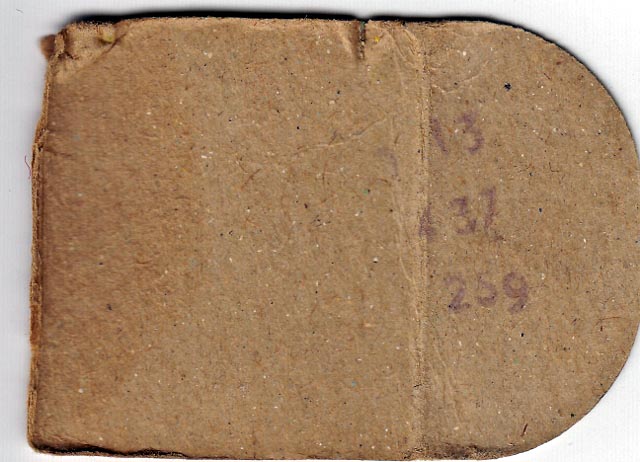
The above end flap unfortunately detached from the box for my 187 Volkswagen Karmann Ghia, the numbers read:
- 43
437
259
The Quality Inspection stamp on the end flap has the last row being 259, February 1959, which is quite surprising considering the model was released in November 1959, although the model is listed in the August 1959 price list as being available in Australia so production could have commenced many months prior to permit the model being included in that price list. Perhaps the numbers should read 1259 but as only three numbers can be used, the “1†has been dropped. Just what the other two rows of numbers denotes I have absolutely no idea!
Further examples of these stamps are below for the 179 Studebaker President Sedan that was released in October 1958:
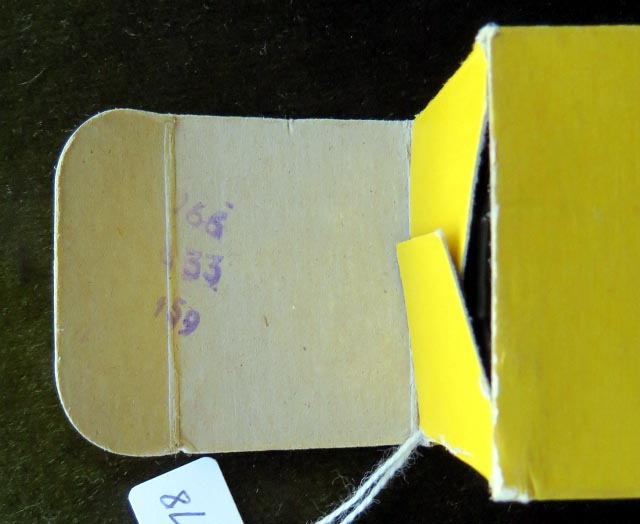

With the above, both models and their boxes were checked in January 1959, the box on the left contains a blue version with ridged hubs, the one on the right a yellow version with spun hubs.
the 176 Austin A105 Saloon


The last line of the inspection stamp reads “758â€, - July 1958. The price on the box is 3/3 – a price that was applicable in the UK from its launch month of April 1958 through to April 1959.
I went through all my boxed models, and could only find two smaller end-flap boxes that had a Quality Inspection stamp containing both letters and numbers of a style similar to that found in the larger lidded boxes. The first box belonged to a very early 623 Army Covered Wagon, whose box did not have the red or black oval on both pictorial sides and was checked in July 1954 (although under a jeweller’s glass the “4†has the appearance of a “3â€, with the other box belonging to an Alfa Romeo 1900 “Super Sprint†that was inspected in July 1961, quite a late date insofar as Quality Inspection Stamps are concerned.
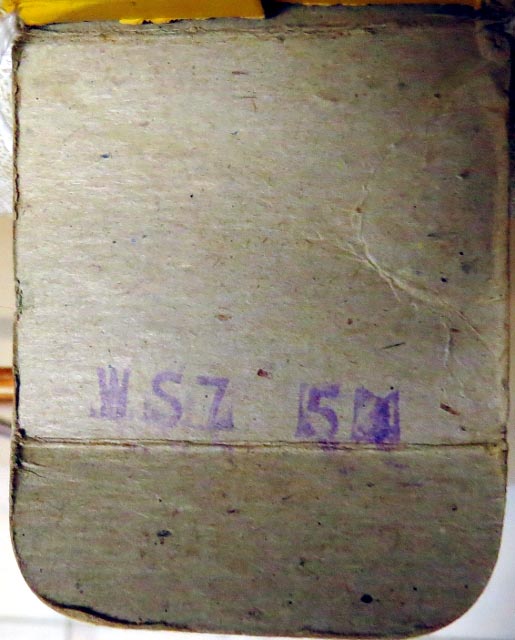
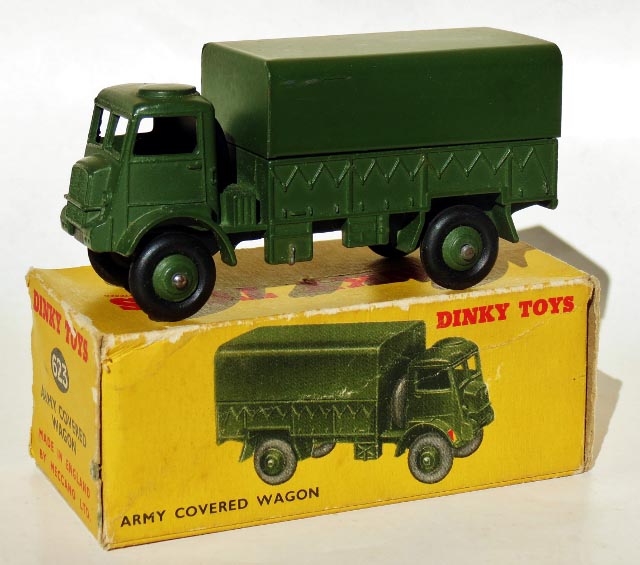
Dinky Toys 623 Army Covered Wagon in its first type of yellow lidded box, quality inspected in July 1954 by “WSâ€, whom I have been unable to locate any more inspected by this individual – assuming these are be the initials of a specific person.


Dinky Toys 185 Alfa Romeo “1900 Super Sprint†– quality inspected in July 1961.
I mentioned earlier that the three rows of numbers that were applied to the vast majority of small end-flap boxes can also be found on the larger lidded boxes. The following are some examples:
999 D.H. Comet Airliner


965 Euclid Rear Dump Truck


The above is my Euclid that has obviously seen better days – and it has! Like my 419 Leyland Comet Cement Wagon, this model was pristine until 1964 when I left home and “someone†allowed another little urchin to “play†with it! I am unable to decipher the rubber stamp, but I know that I was given the Euclid for either Christmas 1956 or 1957. (How I wish I had written the occasion in pencil on the inside of the box somewhere!)
642 Pressure Refueller


The stamp shows an inspection during May 1957
During the same month of May 1957, the quality inspectors were using the usual alpha-numeral stamp as shown with the same 642 models that were going down the production conveyor belt:


A similar stamp was also used for 149 Sports Car Gift Set (EP5 57), 433 Guy Flat Truck with Tailboard (E Z 557), 961 Blaw-Knox Bulldozer (T Z 557), 972 20-Ton Lorry Mounted Crane (557 AE), 642 Pressure Refueller HN 15 57, 660 Tank Transporter F 5 57, 661 Recovery Tractor X5B 7, X5B 57, BX 55, 697 25-Pounder Field Gun Set HN5 57 (same examiner as the 642 pictures above), 981 Horse Box EB 5 57.
We now come to the 660 Tank Transporter.
Shown below is a typical example of the second issue Tank Transporter in 1956 with this box and model being quality examined in June of that year with the usual alpha-numeral stamp. The first production models were in identical boxes, but the trailer was inscribed DINKY TOYS, with the quality stamp seen so far being either EG 556 or MD 556. (Of course there is always a “problem child†– Adrian’s Tank Transporter marked Dinky Toys whose box is stamped HM 856. “HM†must have had an extremely short career with Meccano, as in 15 years of gathering Quality Inspection Stamps, I have never encountered these initials, although I do have a “HN†who quality checked 697 25-Pounder Field Gun Sets in June and July 1956 and May 1957.) Stamps seen so far for the yellow lidded 660 boxes are as follows.
AR556 (many times), EG556, (many times), ER556, MD 556 (May 1956)
ER 656, md656, ph656, PH 656 (June 1956)
L J756, L J 756 (July 1956)
DH 856, ER 856, JB 856, jb 856, MD 856 (August 1956)
EH 056, E1056, H 1056 (October 1956)
Z 4 L 1156 (November 1956)
1 Z 256 (December 1956)
Notice that “ER†“MD or “md†quality inspected in May, June, and August 1956
In November and December 1956, we see the first of the blue stripped boxes being used at the same time as the yellow lidded box stock was finishing its production life.
If a 660 Tank Transporter with windows is being offered, and it is in a yellow lidded box, the model is not in the correct box, as the yellow-lidded box only applies to those models without window glazing that were made in the first seven months of production, not one that did not see the light of day for another 4 years.
Regrettably the yellow lidded box is being sold a number of times most recently through a major auction house in the north containing a model having window glazing. This is totally wrong and is a classic example of how the value of a box is being used incorrectly to increase the value of the model by an unsuspecting buyer and the auctioneer is playing on this lack of knowledge, despite advice being offered on several occasions.
The yellow lidded DINKY TOYS box overprinted on the top with DINKY SUPERTOYS can be found with the following Quality Inspection Stamps:


An example of the second production version packaged in a yellow lidded box, inspected in June 1956 with the first production version in an identical yellow lidded box.



The above Tank Transporter without window glazing and in a blue striped box with italic printing has an inspection stamp of 11 59 PB, which equates to November 1959. The box has an original price written on one end in pencil that states 13/11. This price was current in the UK between May 1959 and April 1961.
Much of the preceding I have discussed in the 660 Mighty Antar Tank Transporter Thread with input from several members, although I will be making a copy of the appropriate sections of this Thread and including it in that Thread.
Well, there we have it. But the story is not complete. What is needed now and into the future is to obtain more details of these Quality Inspection Stamps found on most Dinky boxes, end-flap and lidded, which ultimately will aid in learning more about the production time-frame of our favourite toy models.
One last plea is for information that can explain the meaning of the letters, (are they the initials of an individual?) why some letters have a numeral in the middle, why there is a proliferation of unusual letters, such as X and Z, some in lower case, and what is the meaning of the first two rows of numbers with the three-row numeral stamp.
I have checked, re-checked, read and re-read this post countless times, but if I have missed out on something, or something needs correcting or re-writing to make it easier to read, I will hopefully make any corrections and advise of such in a new post!!
Regards
Bruce (150)
#600
6 June 15
Bruce
What can I say, other than wow.....what an amazing, interesting, detailed post on box QC lettering. It is incredible the amount of data that you have been able to not only glean, but organize. Obviously this is an area that many of us have somewhat overlooked for some time, but it shows just how much we can learn by plotting this information.
Tomorrow, I will look through my boxes and see what I can add. I am asumming you would like us to post our findings here?
Thanks again for making such an important contribution!
Regards,
Terry
Terry
Many thanks for your most appreciated words.
When I came to realize what the stamps meant, it made things better for me as 25 or more years ago after I had picked up my original Dinky Toys from my parent's home, I found that quite a few of my Supertoys had lost their boxes while I had been in Papua New Guinea. I then set about finding replacement boxes, at about the same time I had realized the significance of these stamps on the inside of the box lids.
Knowing approximately when I was given a particular model, for instance my 901 Foden 8-wheel Wagon in red and fawn, I knew that my eldest brother had bought it for me on his last days of National Service in late March 1955. Allowing three months shipping transit time and another month in the warehouse and the toy store where he bought it, Walther and Stevenson Pty Ltd, 395 George Street, Sydney, I then went in search of a box with a stamp prior to December 1954. Well, after four years, an empty box came up on eBay in 2004, with a stamp D 114, or November 1954. So for my purpose, I had found a box of a time frame in which my original could have come down the assembly line. So I am pleased - even if others may think I have taken things too far!! :blush:
I subsequently carried out the same task for each of my other models, including one that had gone missing, a 702 D H Comet Airliner. For me it is nice to either acquire a model and its box, or a box on its own that has a significance with the original. Of course it is quite possible the 901 my brother had bought may have been sitting in Walther and Stevenson for months and months before he bought it - but let us not go down that track!! :laugh:
I look forward to seeing the stamp data from your models on this Thread, with hopefully even a photo or two, or 22, of these stamps, particularly if they are faint. The gaps are important, as I have seen some boxes that I thought were stamped by the same individual, except the stamps had been set up differently, SP859 and SP8 59 as an example with a long space between the "8" and "5".
Many thanks again for you very kind and appreciated post.
Kind regards
Bruce (150)
#611
8 June 2015
Hi Bruce and all,
With all the discussion on the stamps in Dinky boxes, I want to add this piece. I recently bought a boxed #661 Scammell Recovery Tractor to complete the set of boxes (I think). As well as the stamp on the inside of the lid which I think reads PDX1059, it also contained a small tag "Tested By" (as seen in the photo. Of course it may have nothing to do with the Scammell or it could be from another Meccano product (Hornby Dublo?). By the way, do any of the other Meccano products have similar stamps?
The Scammell showing the tag that was actually in the bottom of the box. All the packing pieces are present.
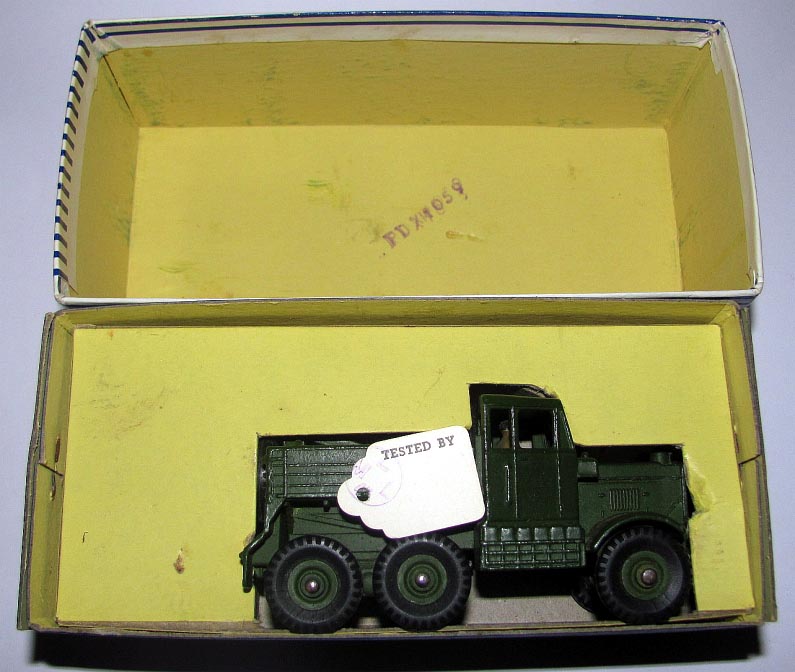
And a close-up of the tag.
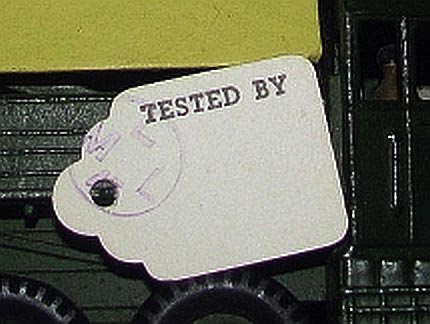
Ron F
Bruce--
Well, I took the plunge and spent most of yesterday going through my boxes and taking many photos. It immediately became apparent that some make lots of sense and are very clear and somewhat easy to decipher, while others do not seem to fit, or are just not very legible. It does not appear that there was much of a standard, or else it was constantly changing! I will not dare try to post all that I went over, but here are a few to ponder.............
The first is the 923 Big Bedford van, in the sauce or ketchup bottle version. Here is both the box and the QC stamp on the lid:
The stamp appears to be 4K 58, which makes sense....
But here is the earlier, 923 Big Bedford van, in the bean can version.........
This stamp is harder to read and figure out....at first glance, it appears to show 30? ?59.....but 59 cannot be the right year.......so what is it?
This next one shows another form of QC marks, unlike any that you displayed. This one and a few others are stamped on the end of the box, in this case the 521 Bedford Articulate Lorry
This stamp appears to show NQ 31.9
And lastly, here is an altogether different looking stamp that I only found on an early Foden box, a 1st type 501 Flat Truck:
This is a small circle and it appears to show the numbers 19 42 in it...........but, again, that cannot be right, so was this some other form, and have you seen it before?
Regards,
Terry
micromodels wrote:
"Hi Bruce and all,
With all the discussion on the stamps in Dinky boxes, I want to add this piece. I recently bought a boxed #661 Scammell Recovery Tractor to complete the set of boxes (I think). As well as the stamp on the inside of the lid which I think reads PDX1059, it also contained a small tag "Tested By" (as seen in the photo. Of course it may have nothing to do with the Scammell or it could be from another Meccano product (Hornby Dublo?). By the way, do any of the other Meccano products have similar stamps?
The Scammell showing the tag that was actually in the bottom of the box. All the packing pieces are present.
(IMAGE DELETED - SEE RELEVANT POST ABOVE)
And a close-up of the tag.
(IMAGE DELETED - SEE RELEVANT POST ABOVE)
Ron F"
Hello Ron
I too have seen a "Tested" tag, of the kind your photos depict in other Supertoy boxes. I will have to go through all mine again! I think mine was with a 972, so it is possible all the models with a winding handle were inspected prior to being boxed as a sign the jib(s) operated as it should. Then another person checked the exterior and base before going into the box and it being stamped. This tag is the stock standard Hornby-Dublo tested tag that signifies that the locomotive has been operated around a test track before being boxed. The box also carries in most cases, a stamp similar to the Dinky stamp, particularly with the individual boxed rolling stock.
If only a member (or perhaps even a "guest" to this site) living in Liverpool could find ladies who once worked in Meccano, we may be able to have an answer direct from the source rather that all this conjecture!!
AS for your stamp, I have seen and noted instances where an X has been used to denote a "10" which may explain some of the X markings seen. Maybe the "Y" mentioned in my original post was a code to represent a "12" - who knows!!
But with your code of PDX1059, it "could" denote 10 October 1959 with some person wishing to be explicit with the exact date.
All this IF and COULD!!
Kind regards
Bruce (150)
#614
11 June 2015
dinkyfan wrote:
"Bruce--
Well, I took the plunge and spent most of yesterday going through my boxes and taking many photos. It immediately became apparent that some make lots of sense and are very clear and somewhat easy to decipher, while others do not seem to fit, or are just not very legible. It does not appear that there was much of a standard, or else it was constantly changing! I will not dare try to post all that I went over, but here are a few to ponder.............
The first is the 923 Big Bedford van, in the sauce or ketchup bottle version. Here is both the box and the QC stamp on the lid:
(IMAGE DELETED - SEE POST ABOVE)
The stamp appears to be 4K 58, which makes sense....
But here is the earlier, 923 Big Bedford van, in the bean can version.........
(IMAGE DELETED SEE ABOVE POST)
This stamp is harder to read and figure out....at first glance, it appears to show 30? ?59.....but 59 cannot be the right year.......so what is it?
This next one shows another form of QC marks, unlike any that you displayed. This one and a few others are stamped on the end of the box, in this case the 521 Bedford Articulate Lorry
(IMAGE DELETED - SEE POST ABOVE)
This stamp appears to show NQ 31.9
And lastly, here is an altogether different looking stamp that I only found on an early Foden box, a 1st type 501 Flat Truck:
This is a small circle and it appears to show the numbers 19 42 in it...........but, again, that cannot be right, so was this some other form, and have you seen it before?
Regards,
Terry"
Hello Terry
Many thanks for your contribution. As you have written, the first 923 is easy to read, however, the second 923 is as you stated a little difficult to understand. There are three possible answers. First the box is a "find" in late 1959 and was used to originally house a tomato sauce bottle version. Secondly, and more feasible, the stamp "lost" its last row of numerals, and the examiner may not have noticed its absence. The final possibility is we know that the can version was in use from 1955 to 1958, and the sauce bottle from 1958 to 1959. What if those dates are incorrect and that the can version went up to December 1958-January 1959 with the can version 1959 only? In other words a "cross-over" time frame of late December 1958 to early January 1959? This would then make the stamp a confirmed 159. Although this hypothesis may not be accurate as the sauce bottle appears in print in April 1958. So I guess we are back to the first two possibilities!!
I presume none of the 923 boxes have a price written anywhere?
In regard to the quality inspection stamp on the end of your 521, many thanks for including it, as I had completely forgotten about its existence as I have a noted a similar location for the quality inspection stamp as shown on your 521 Bedford. I presume this was an error which may have been corrected very quickly due to its existence being rarely seen.
With your 502, the stamp on all the plain cardboard boxes is a test/examination stamp that was common with all immediate post-war boxes including the plain as well as the green covered boxes up until the boxes were changed to blue covered. The stamp has letters and is of a similar style to that used in the French factory.
Thanks again for sharing with us these box details.
I will be writing to you direct on this fascinating subject.
Kind regards
Bruce (150)
#615
11 June 2015
Bruce-
Thanks for your comments.....a most interesting topic to me at least......I notice that we have a small group so far! I will post some more of these next time, including at least one other example of an early box with the QC stamp on the end of the box, similar to my 521.
You mentioned French Dinky's....I have never noticed these same type of markings on any of mine...have you? I have noticed other types of stamps, but not with dates............
It is kind of maddening....some of the stamps are very clear and well marked, and others are just a blur..........but it is nice that we have at least some of them. To answer your question on the Big Bedford Vans, no, neither one has any pricing marked on the box...........so no help there!
Regards,
Terry
Terry
It is nice to see you becoming fascinated with this aspect of Dinky Toys and to have someone of "kindred spirit", (from a famous book based on the life of an orphan growing up in Newfoundland, Canada), is most appreciated! I must go in search of the QIS on the end label that I have observed, and hope it is not one of those models that I have passed onto someone else! I will photograph a French Supertoys with a similar round stamp as on the early British Supertoys boxes.
I have had another look at your 501 stamp and I think it is actually "M 42".
Attached is the stamp on the base of my 512 Guy Flat Truck (I can never tell with this colour whether it is maroon or dark brown!) that shows a similar stamp to yours, that is also similar to the stamp used in the French factory:
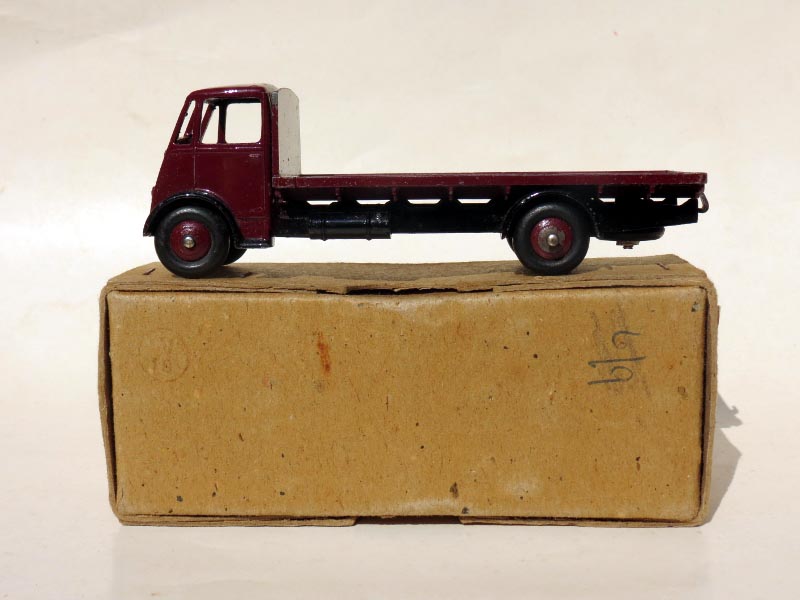
Processing the image by increasing the saturation, adjusting the exposure, contrast, etc, etc, makes the stamp a little clearer,

which at first looks like "N 18" but is actually "M 18" as one has to turn one's head slightly to see it in a vertical plane. It can be presumed that the numeral represents the person checking the item.
After several years and no doubt with the increase in the products of Supertoys, Meccano must have decided it would be best to introduce a code of letters for the individual and then numerals to reflect the month the item was checked.
Kind regards
Bruce (150)
#617
11 June 2015
Bruce--
Here are some more QC markings for you to ponder...........
First one is the 14C Coventry Climax Fork Lift, which I got as a child
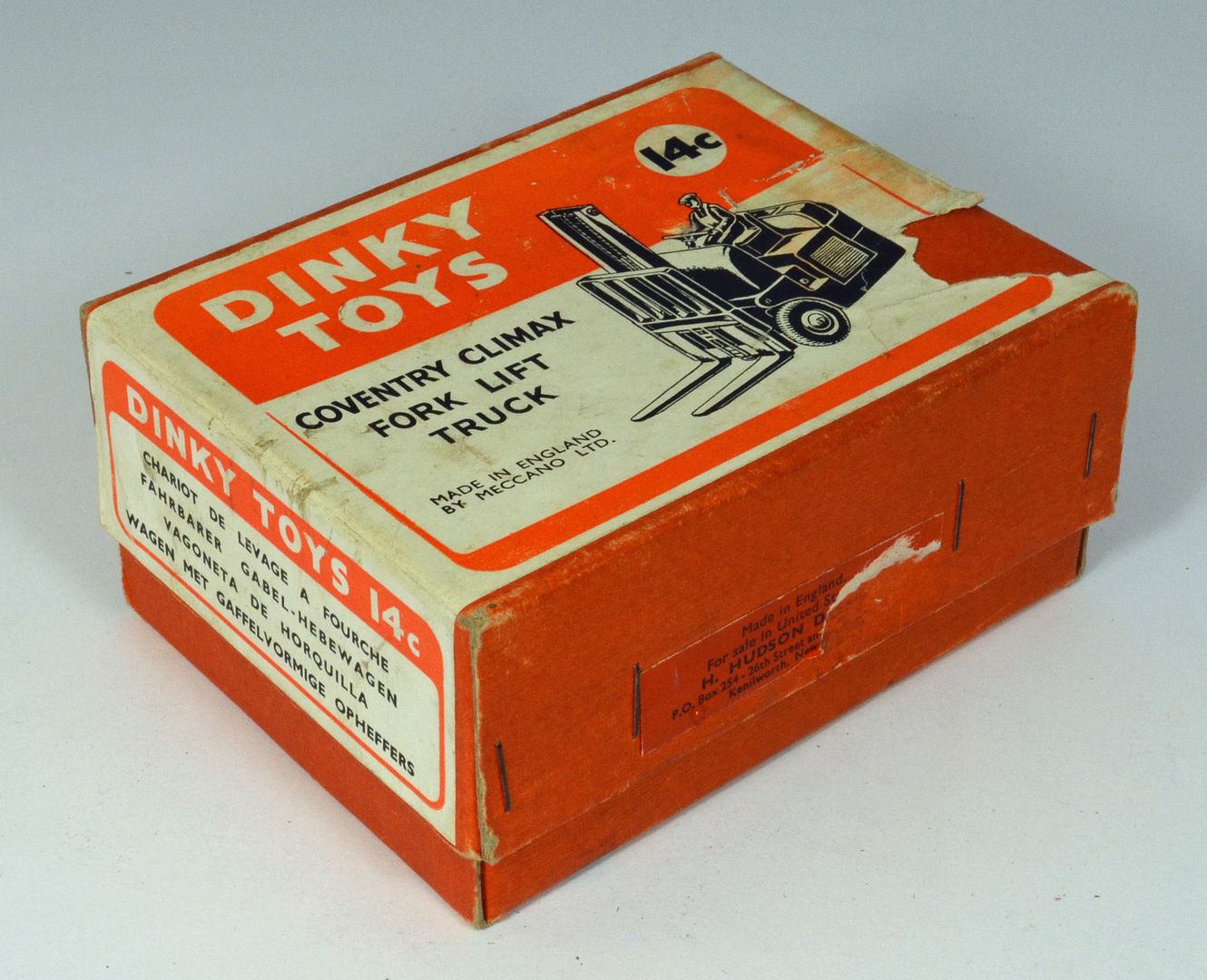
here is the QC marking....looks like 1953?
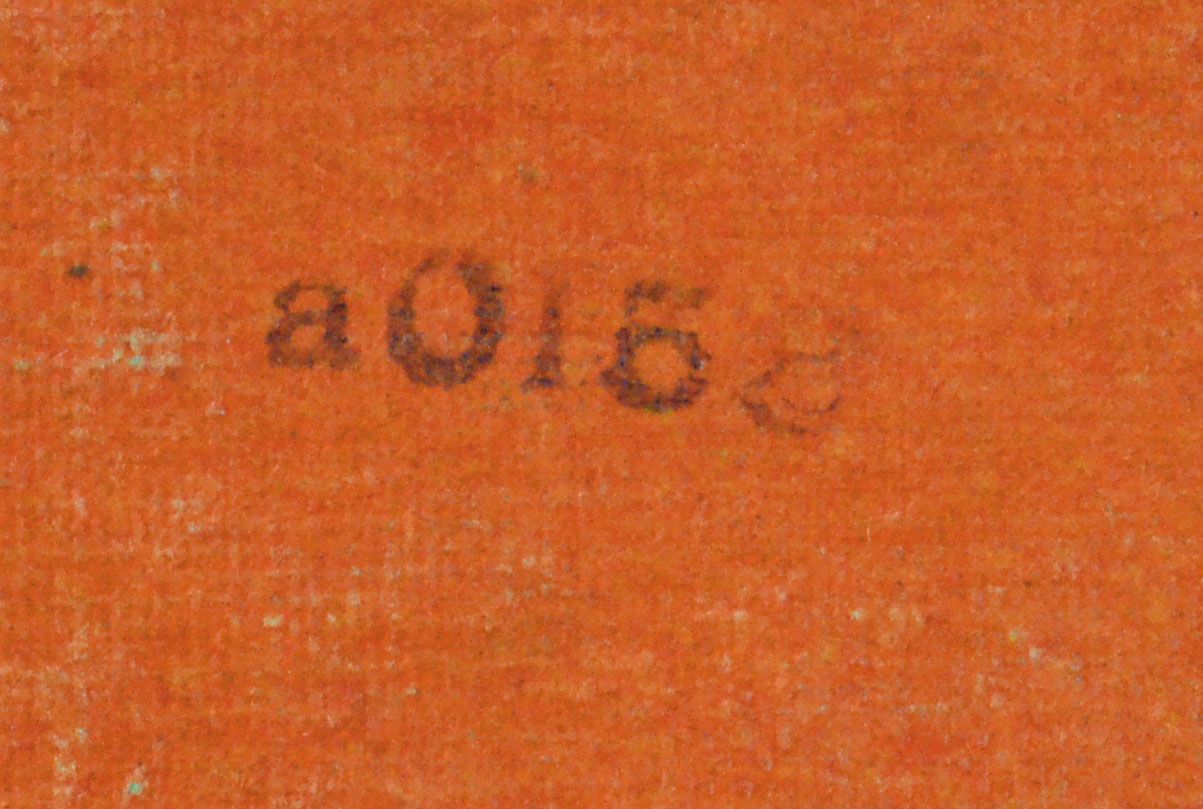
Next is the 751 Supertoys Lawn Mower:
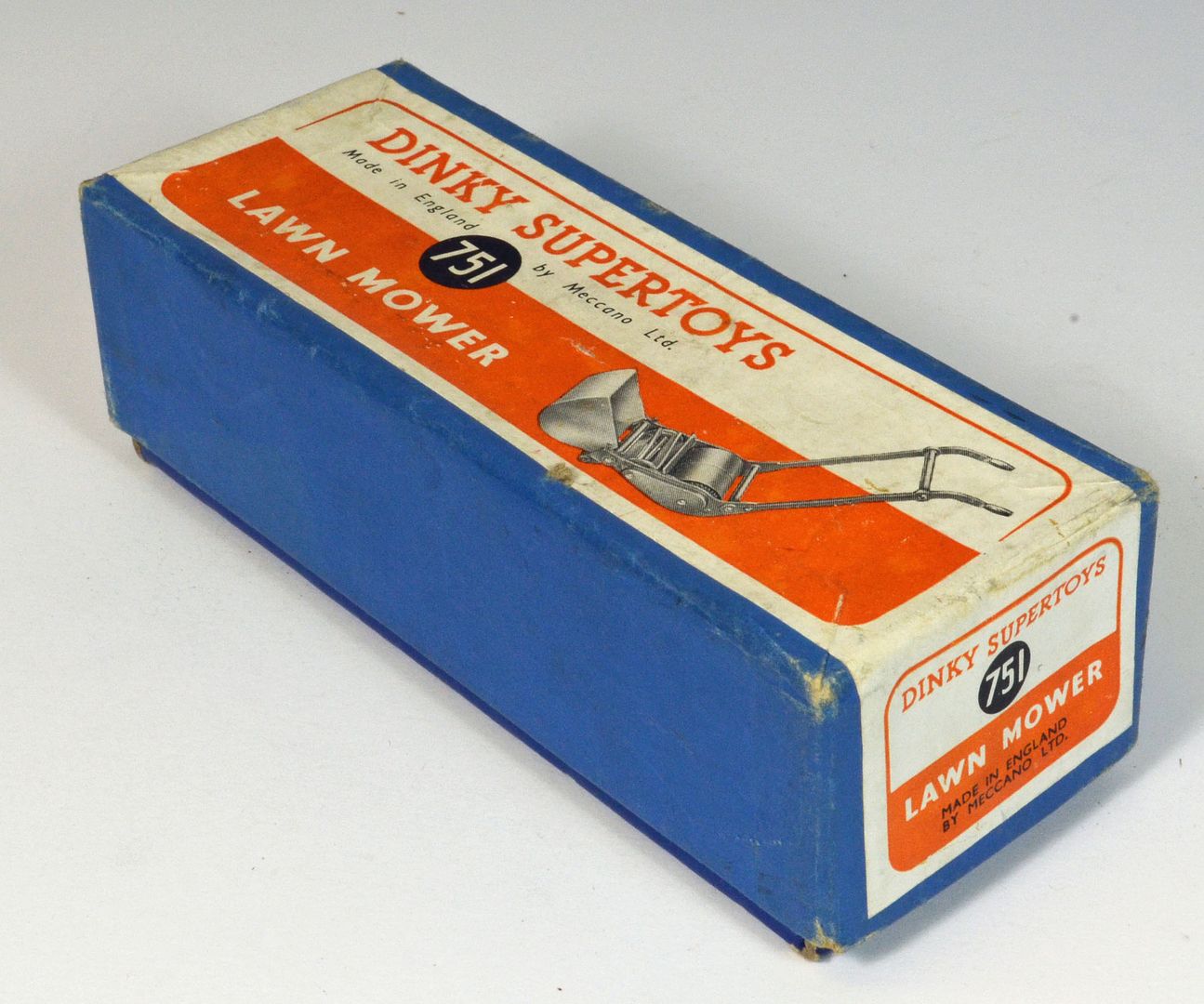
This is another example of the markings on the box end

Next is the 622 10-Ton Army Truck, another model that I received...I think for Christmas in 1955
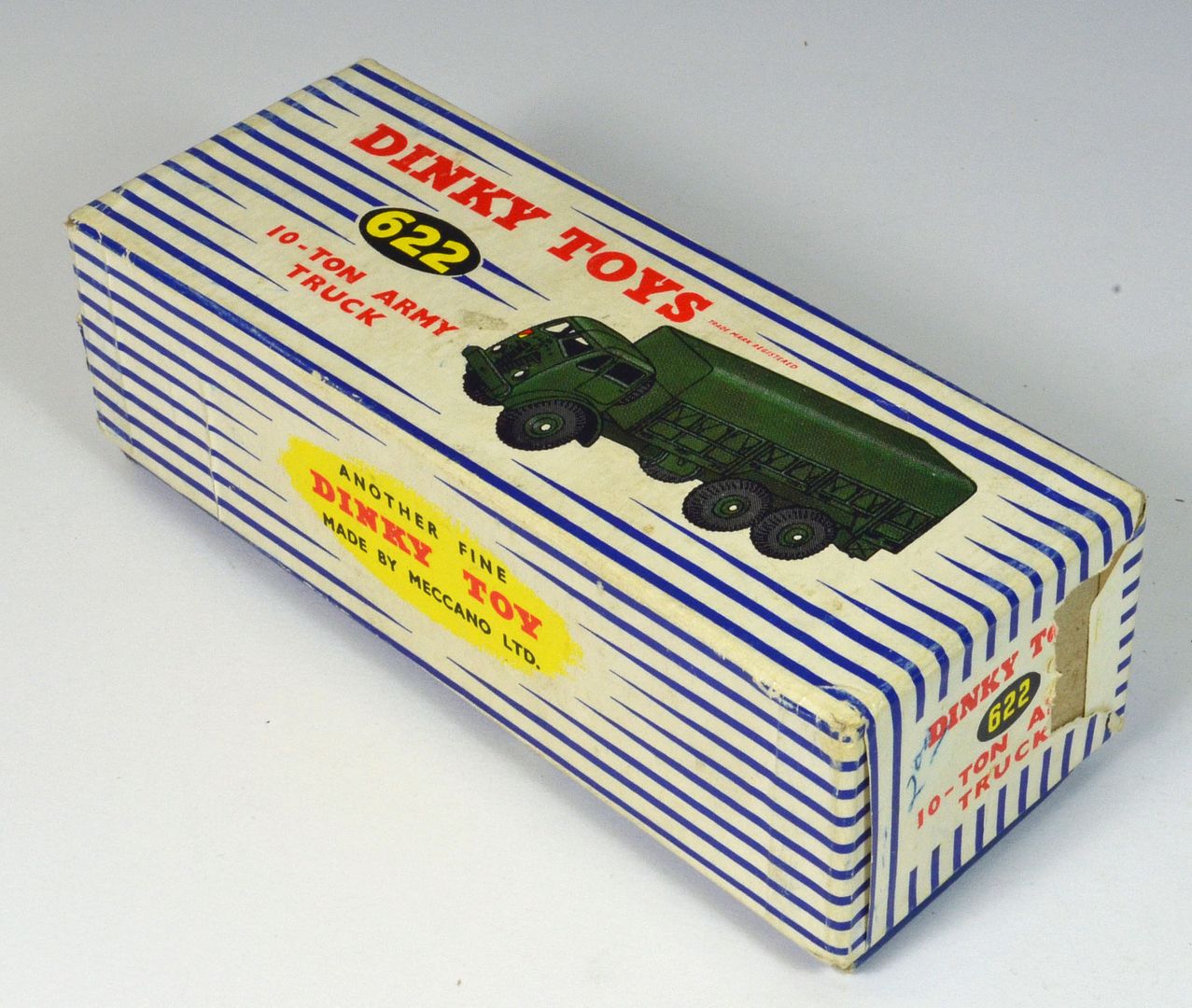
Here is the QC marking.....looks like 1954
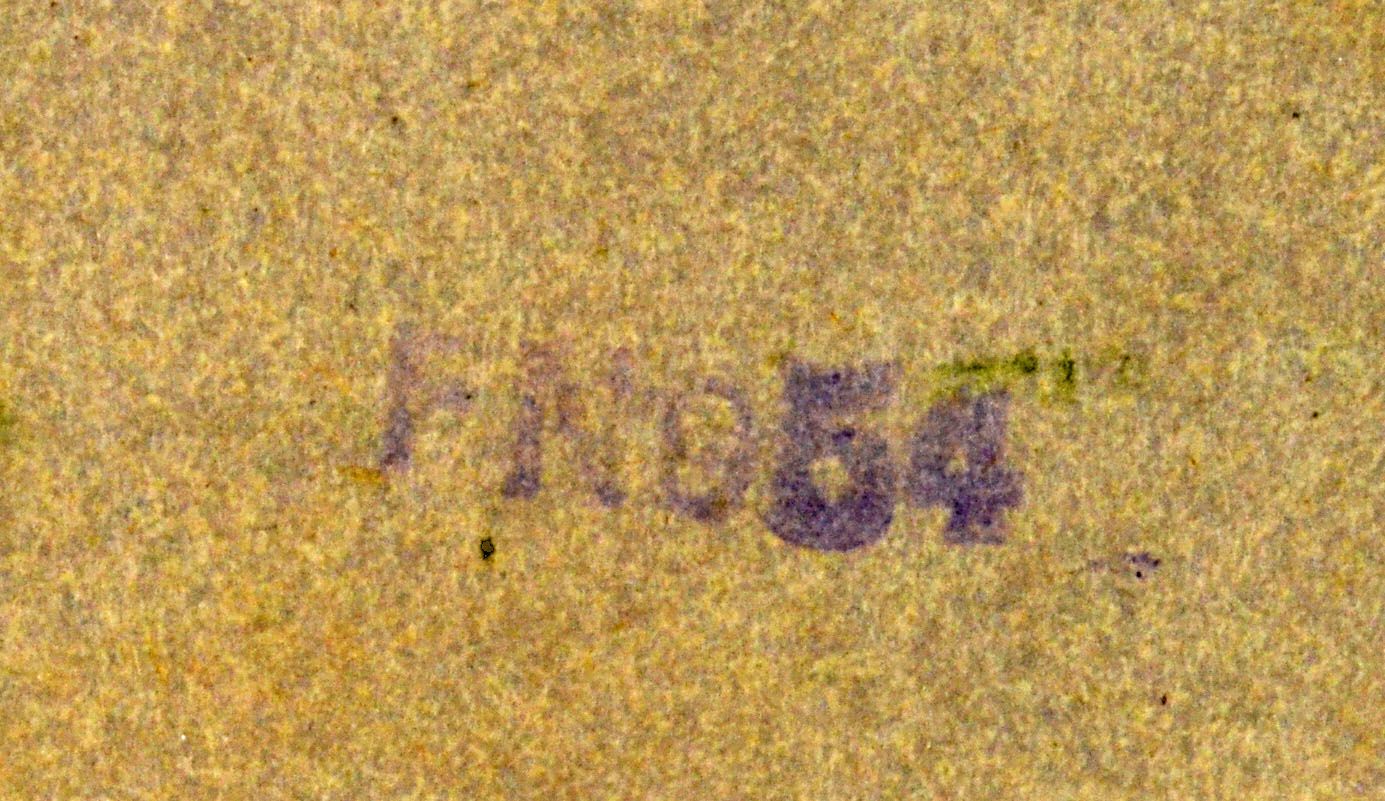
Next is the 49 Petrol Pumps
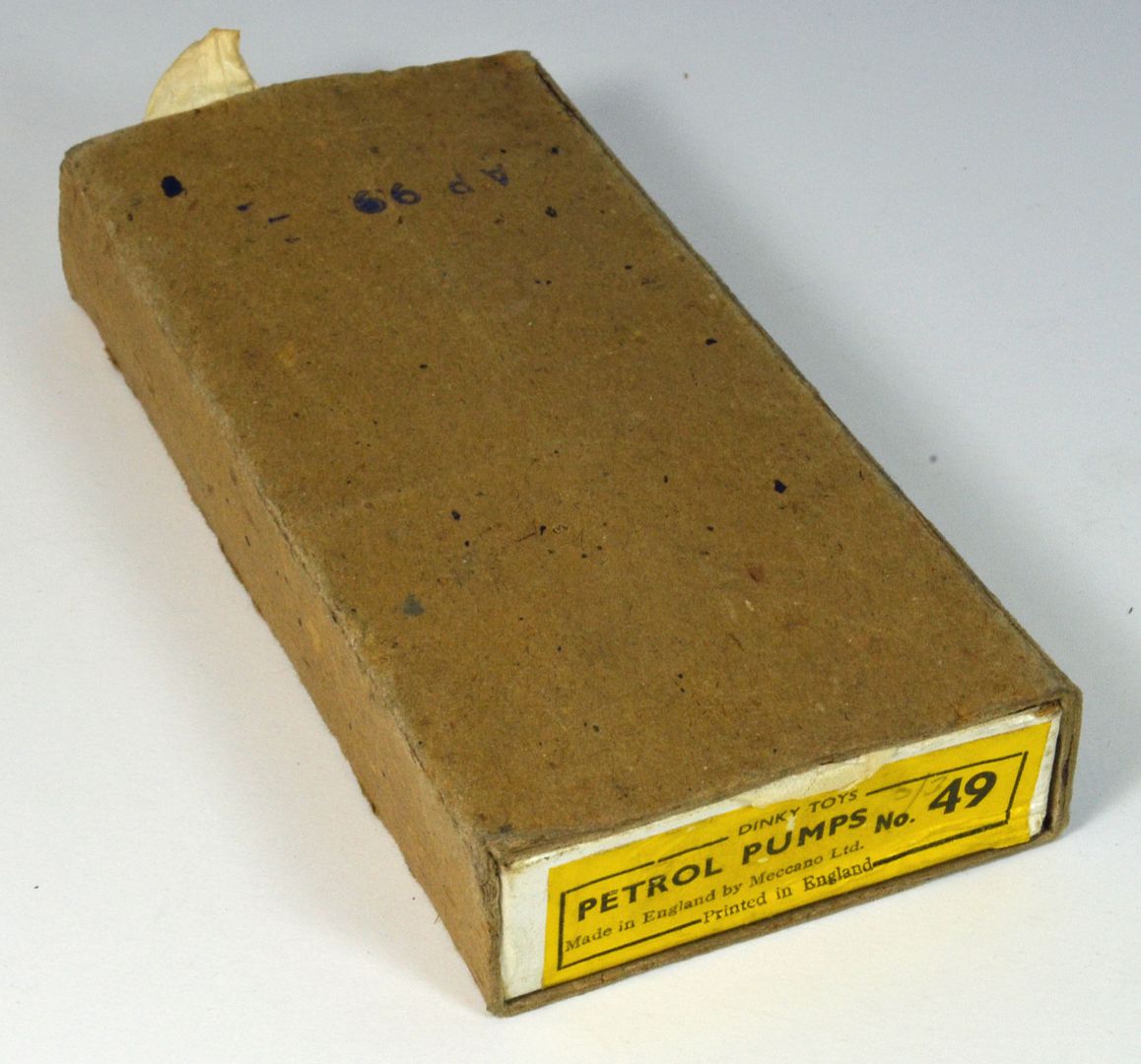
and the QC marking.....1949?

And, lastly for now, the 1st version 504 Foden Tanker
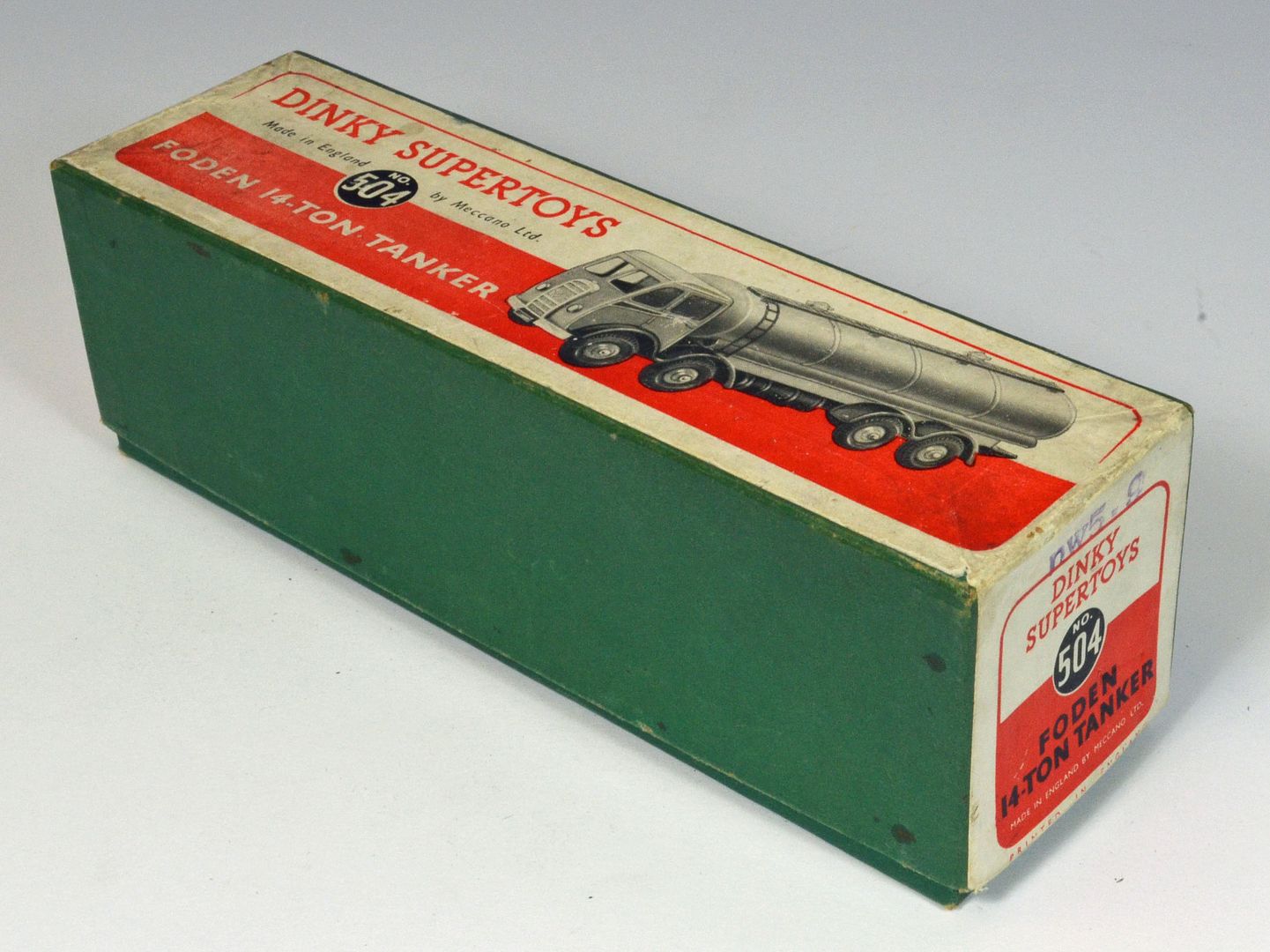
And the QC marking....another one shown stamped on the end of the box....1949?
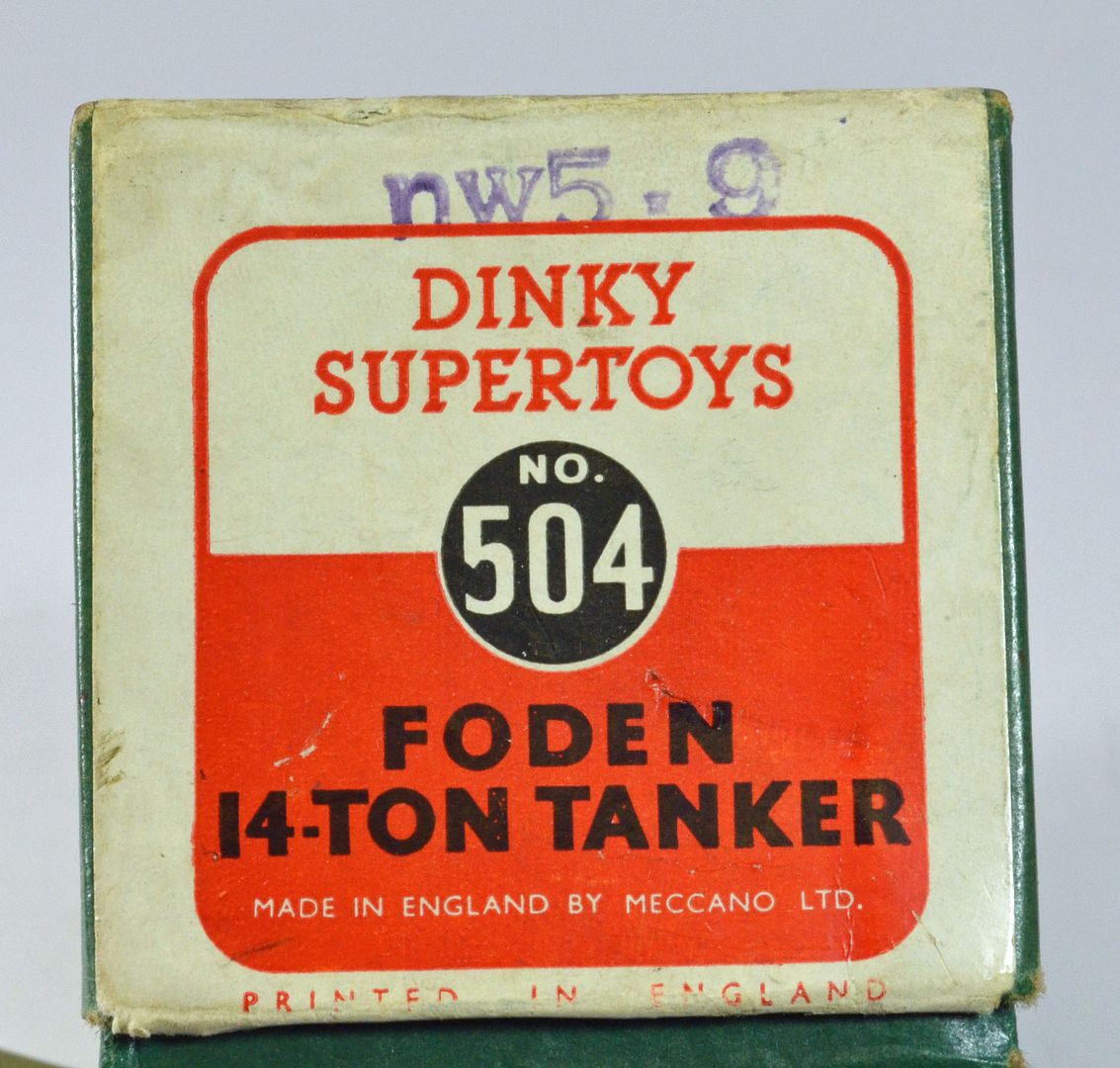
Regards,
Terry
Greetings Terry
Thank you again for your valuable contribution to this Thread. Hopefully I can answer all the Quality Inspection Stamp data you have graciously provided!
1) 14c - Coventry Climax Fork Lift Truck - I read the stamp as aO 153 = January 1953
2) 751 - Lawn Mower - E P 5 9 = May 1949, price on the box - 5/-. Price as per Meccano Price Leaflet April-May 1949 5/-. Model released June 1949 as per announcement in MM, price 5/-. This price remained current until February 1950 when it was increased to 5/6.
3) 622 - 10-Ton Army Truck - FN 9 54 - September 1954
4) 49 - Petrol Pumps Set of 5 - AP 99 = September 1949 Price 3/3 in pencil - September 1948 to January 1950 price 3/3
5) 504 - Foden 14-Ton Tanker - nw5.9 = May 1949 (Green covered boxes introduced March 1949 and withdrawn October 1949)
It is nice to see your 751 with the UK price matches the period of the quality inspection stamp.
These have been added to my data base, and many thanks for the considerable time you have devoted to this subject. It is highly valued and appreciated.
I look forward to receiving more Quality Inspection Stamp data in the time ahead.
Kind regards
Bruce (150)
#646
17 June 2015
Of all my models in a lid box, only my 965 Euclid with a yellow / red lid box had a white control label “Tested By”. There was no stamp in the box. I thought that was strange. I couldn't find any information about it in existing documentation from Richardson and others.
That's why I went to Vectis auction to search for more Dinky Toys models with a “Tested By” control label.
I searched on Vectis with the catch “Dinky tested by” and found 3 pages with a total of 38 Dinky Toys models with box, whereby the auction description stated the presence of a “tested by” label in the box. With the catch "Dinky tested" I even found 8 pages with even more mentions of tested labels.
What is striking is that it concerns Dinky Toys with lid boxes of various Dinky Toys models with a lifting, winding or tilting mechanism or battery operated, in which normally a control stamp could also be present.
This confirms Bruce's explanation in comment # 6: “I too have seen a" Tested "tag, of the kind your photos depict in other Supertoy boxes. I will have to go through all mine again! I think mine was with a 972, so it is possible all the models with a winding handle were inspected prior to being boxed as a sign the jib (s) operated as it should. Then another person checked the exterior and base before going into the box and it being stamped. This tag is the stock standard Hornby-Dublo tested tag that signifies that the locomotive has been operated around a test track before being boxed. The box also carries in most cases, a stamp similar to the Dinky stamp, particularly with the individual boxed rolling stock. ”,
Even a 27k Hay Rake and 310 Farm Tractor and Hay Rake had a white control tag "Tested By". It's a very small label that can easily be overlooked or lost. You can say when you still have this control label in the box with your model, you have a premium.
This white “Tested By” tag is indeed used on Hornby Dublo trains. I have found pictures of it that I attach to this.
Jan Oldenhuis, 21 September 2020
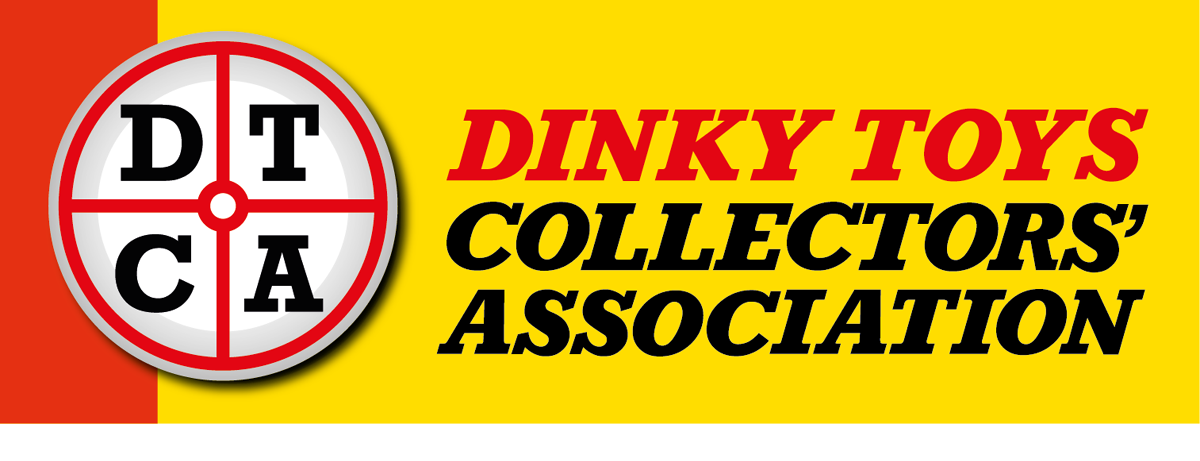

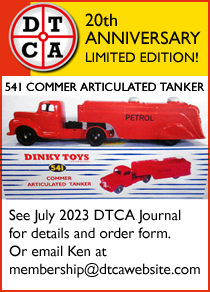

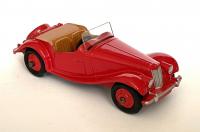
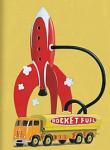
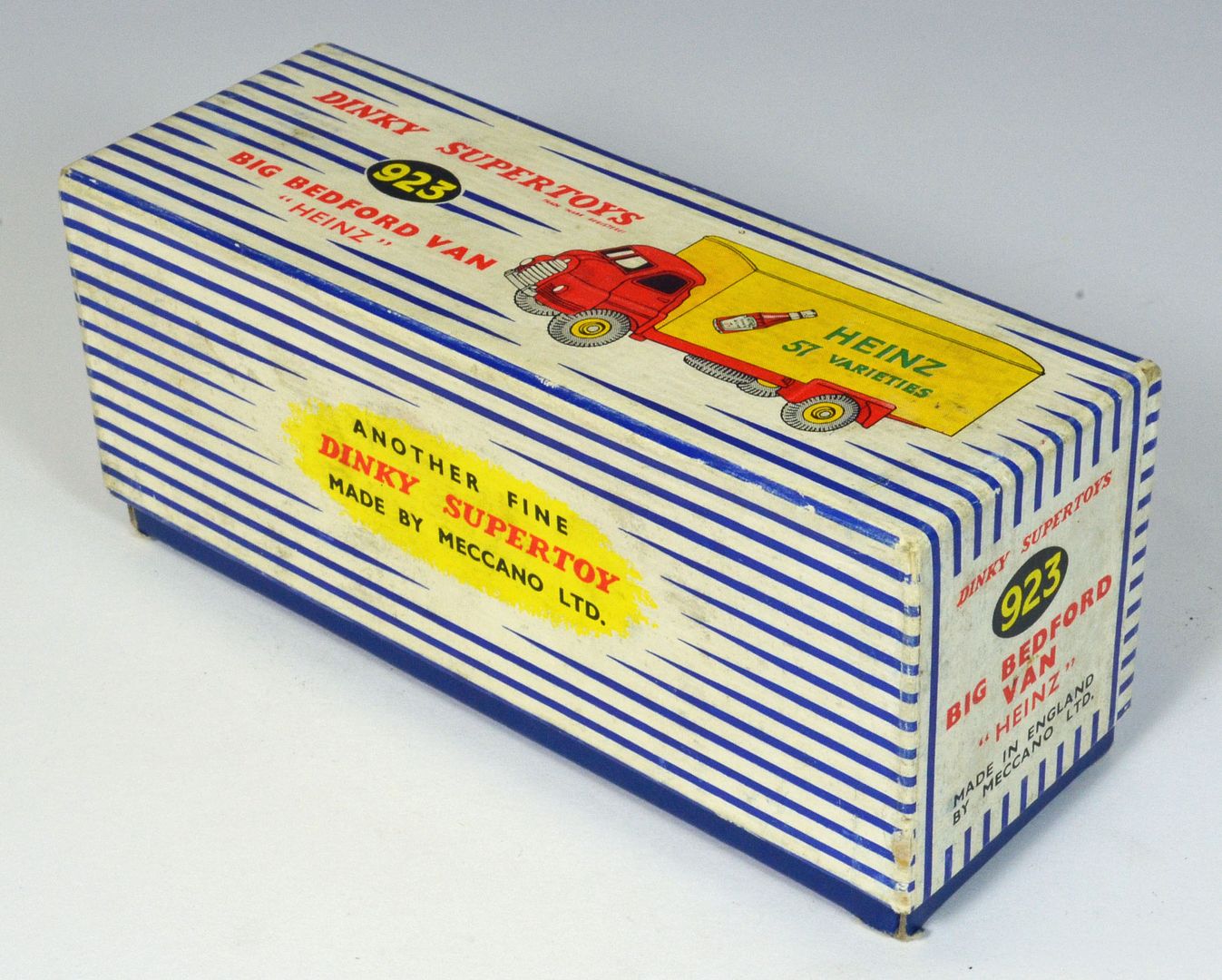
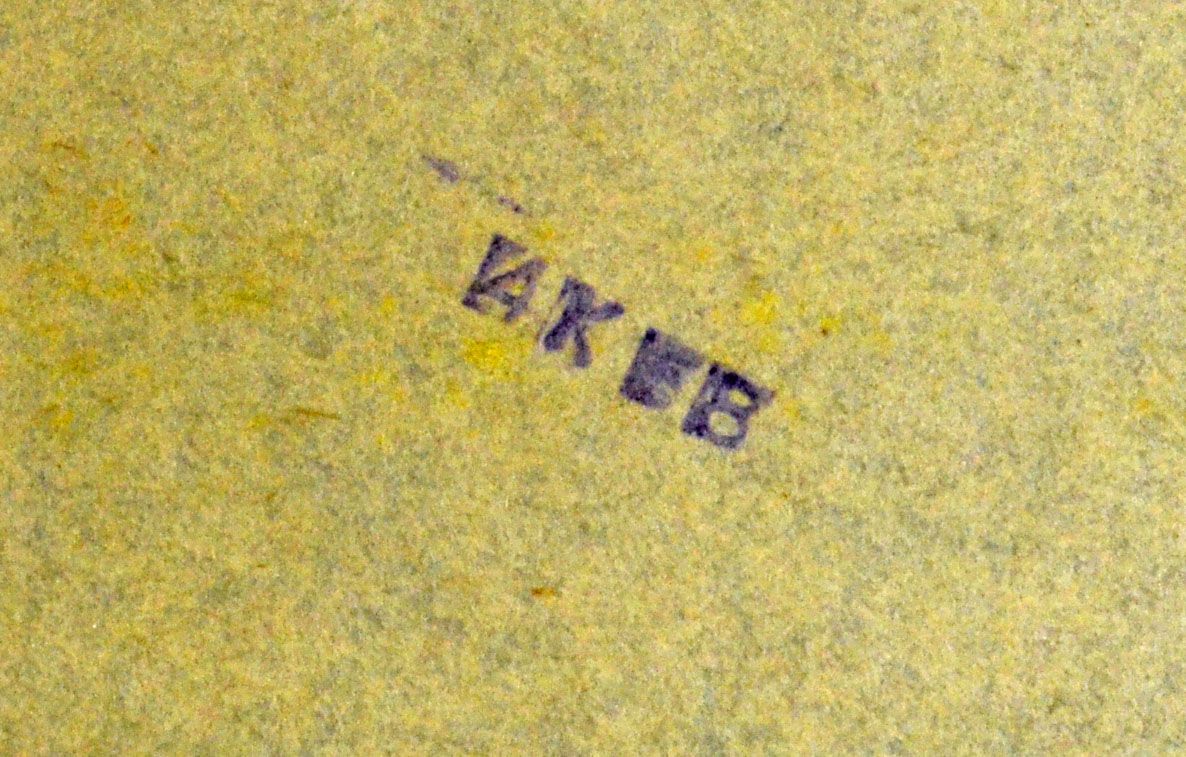
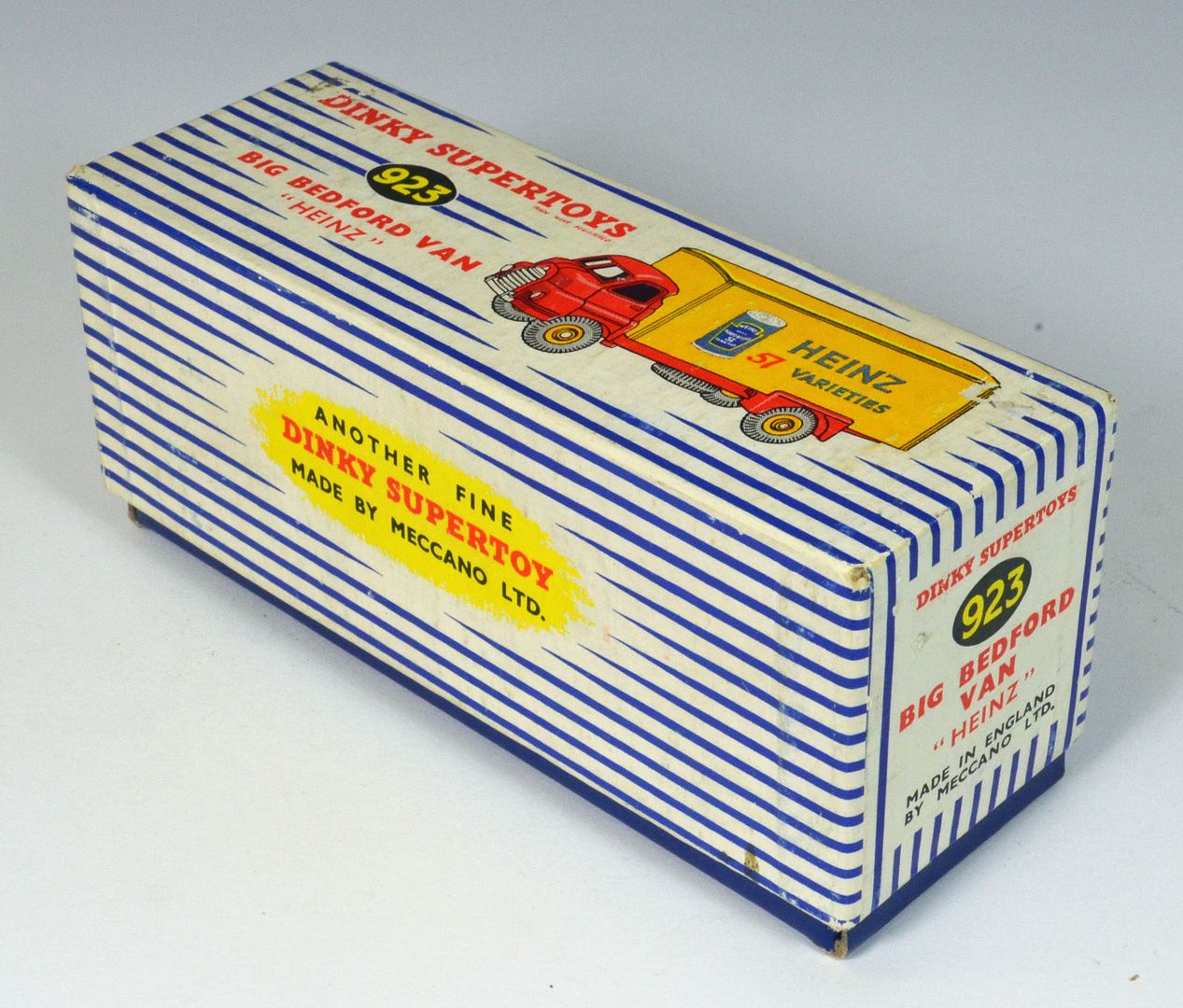
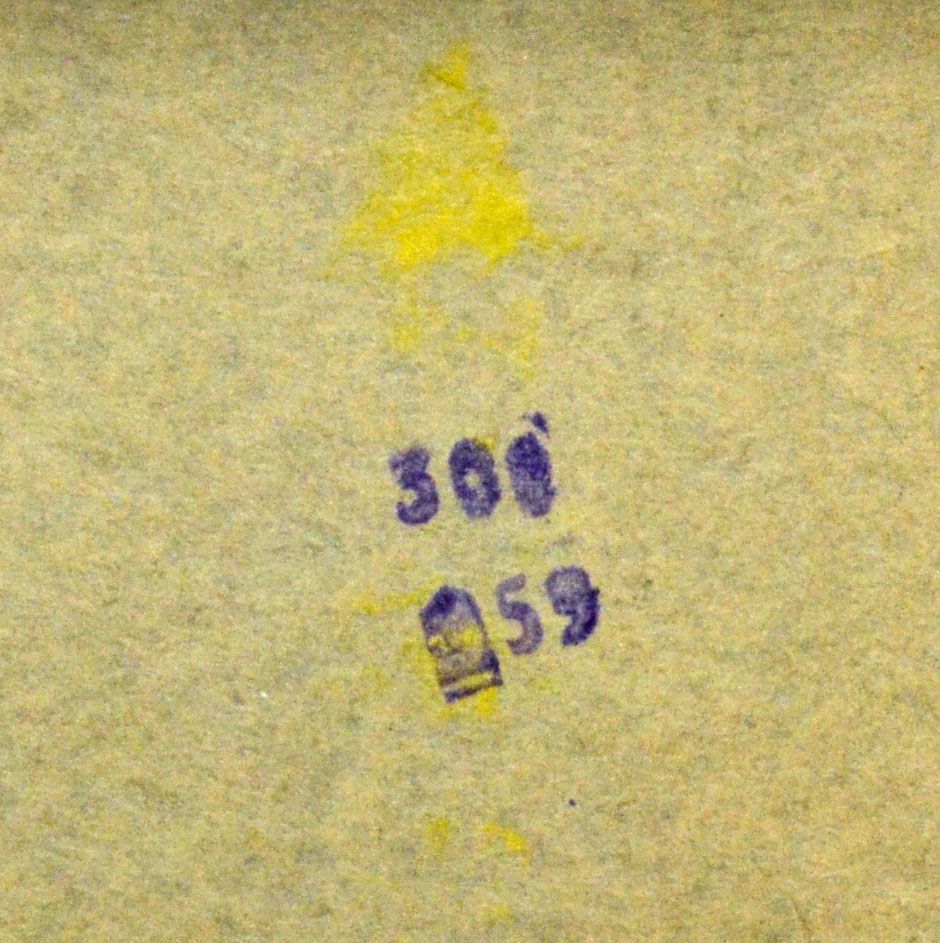
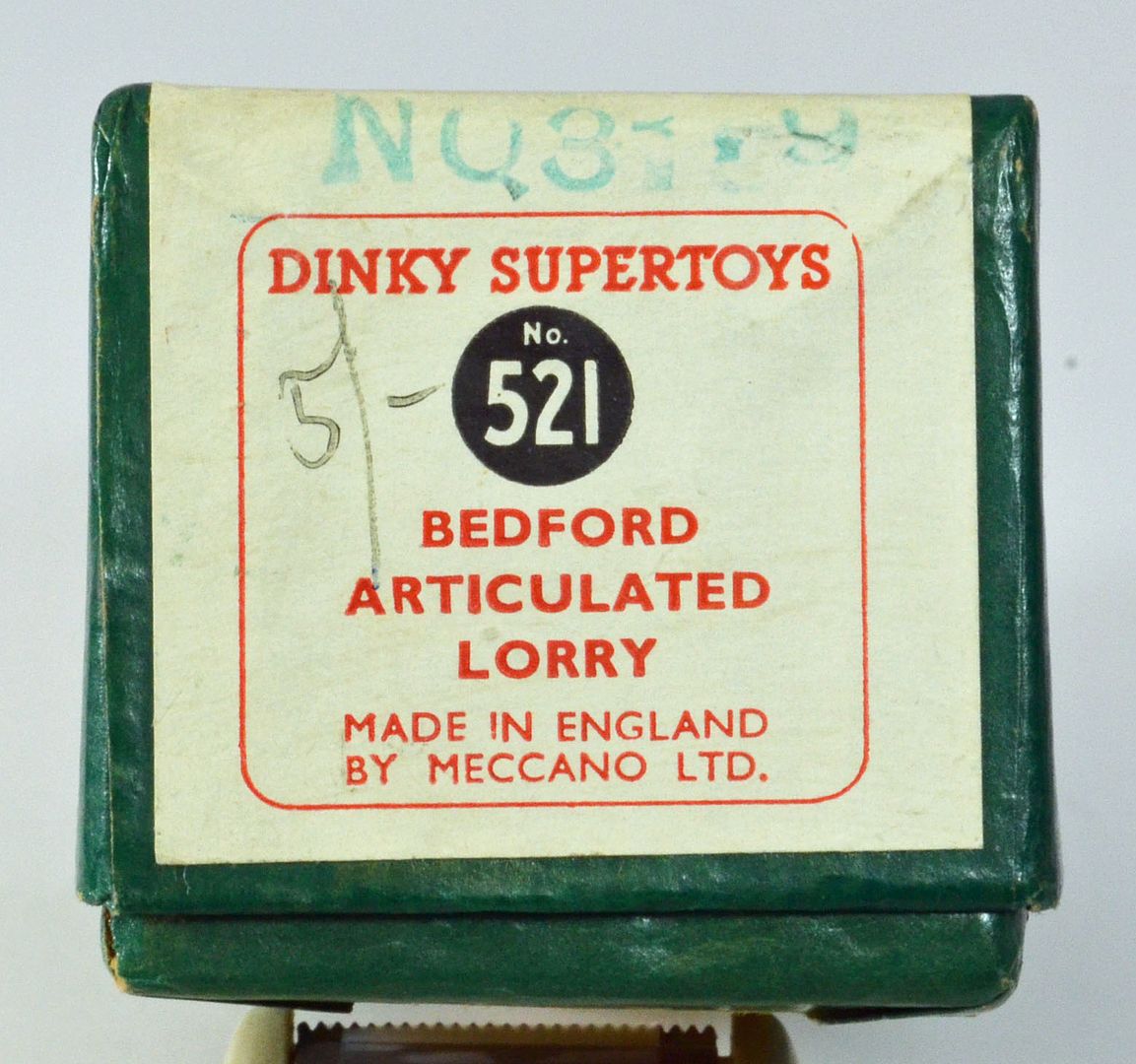
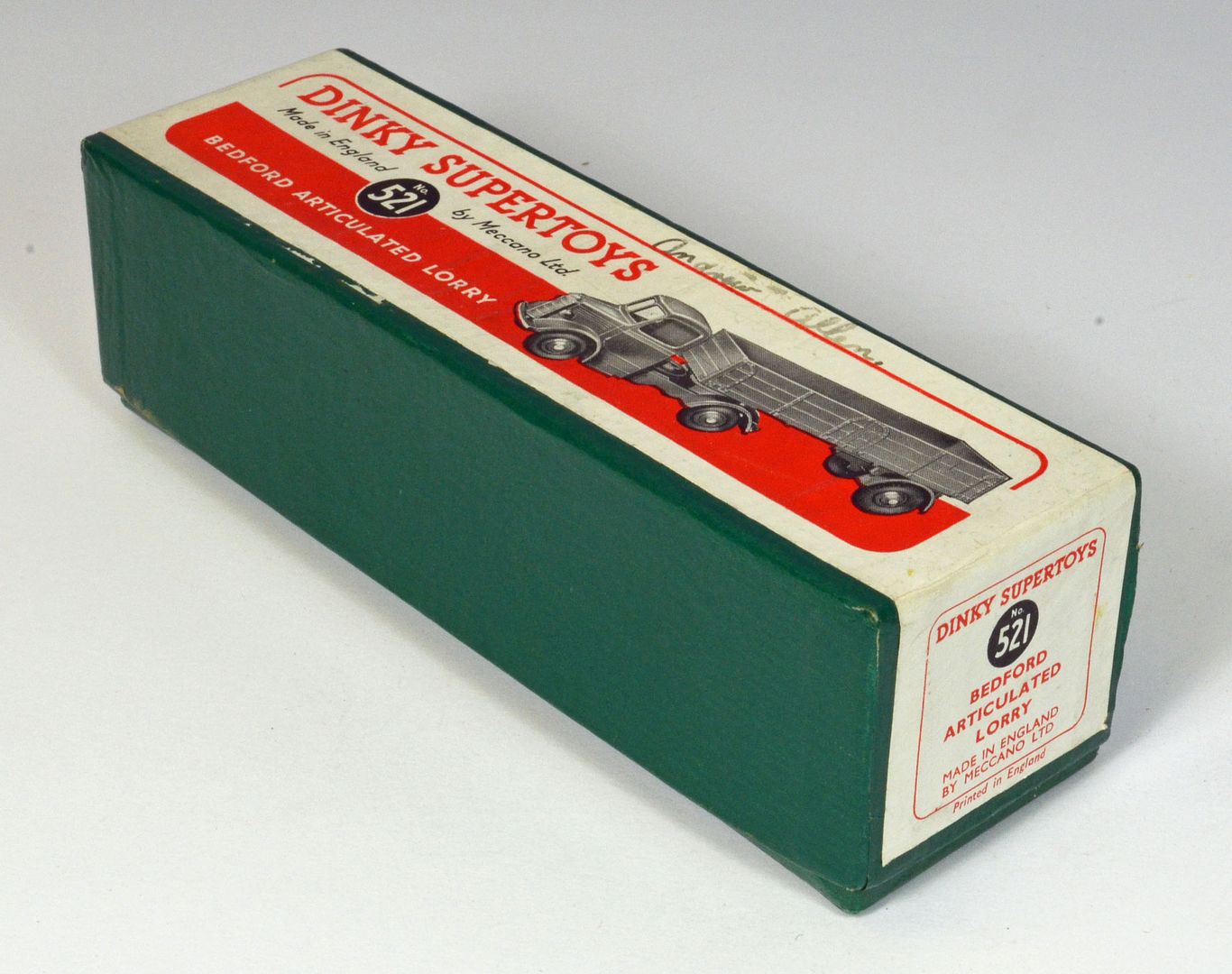

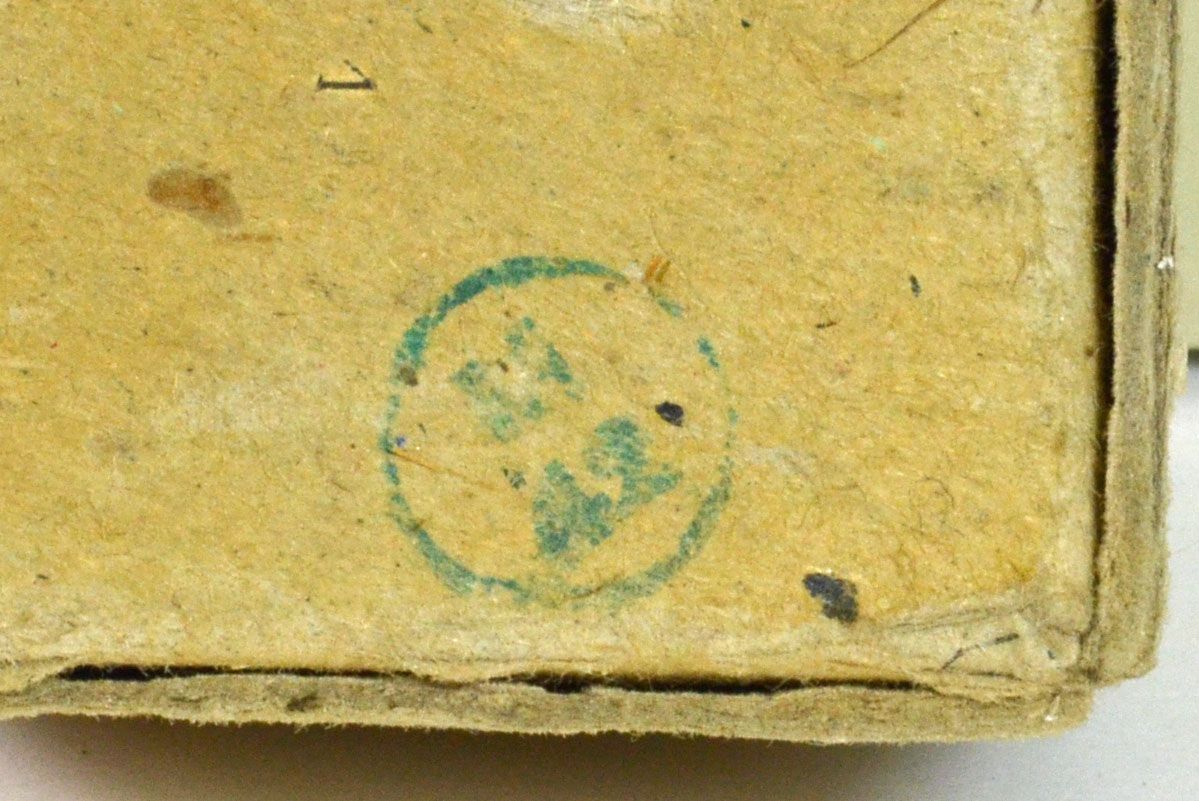

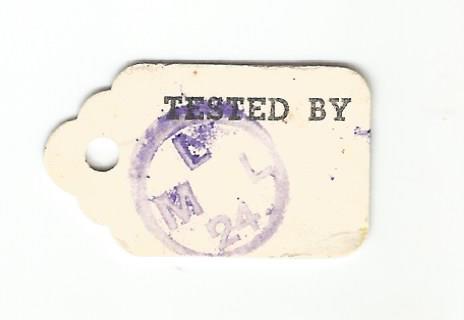
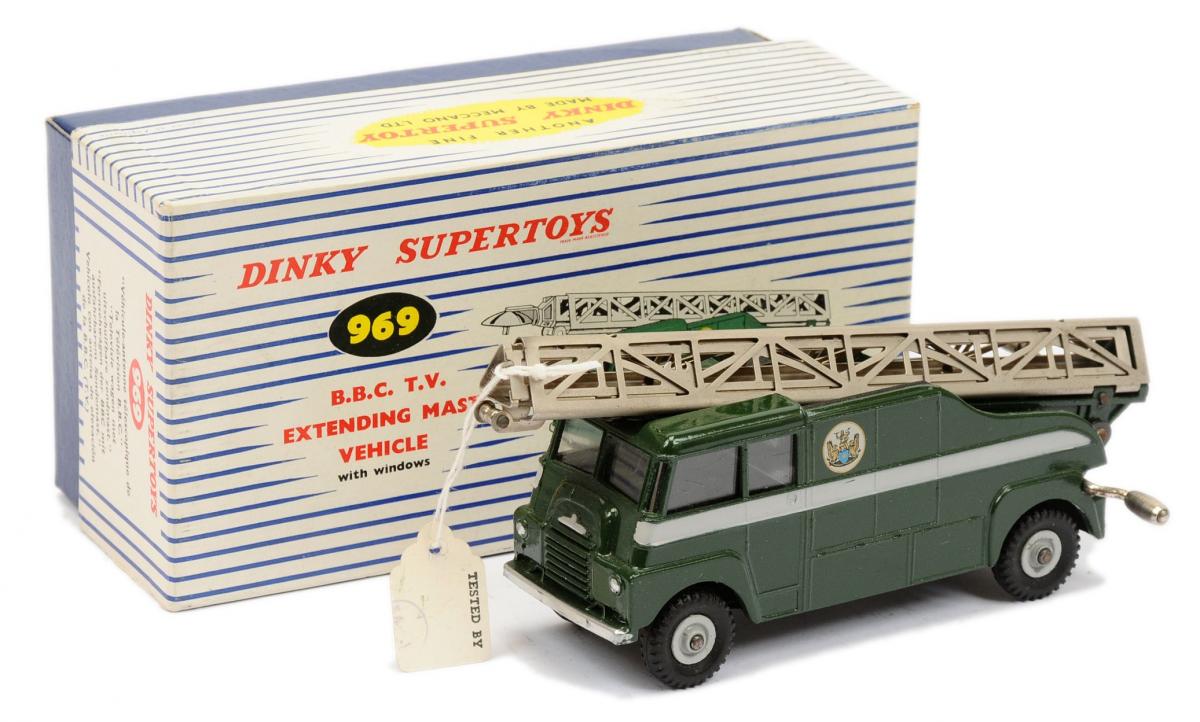
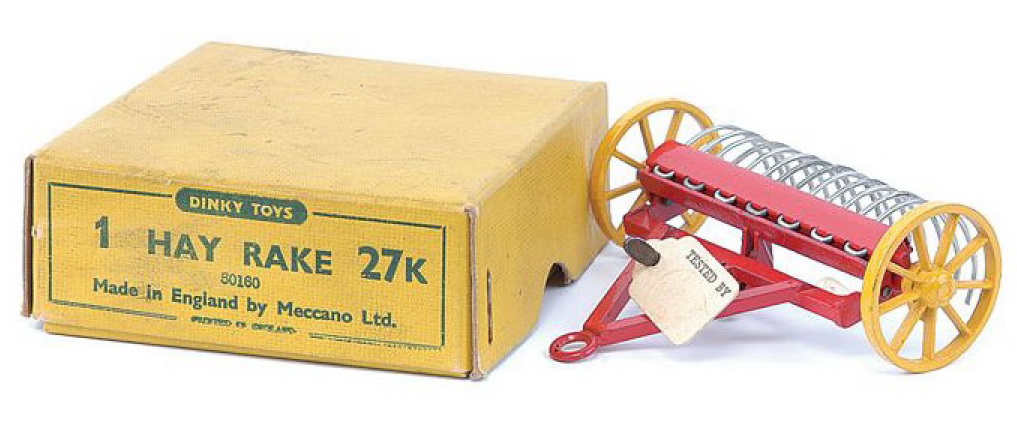

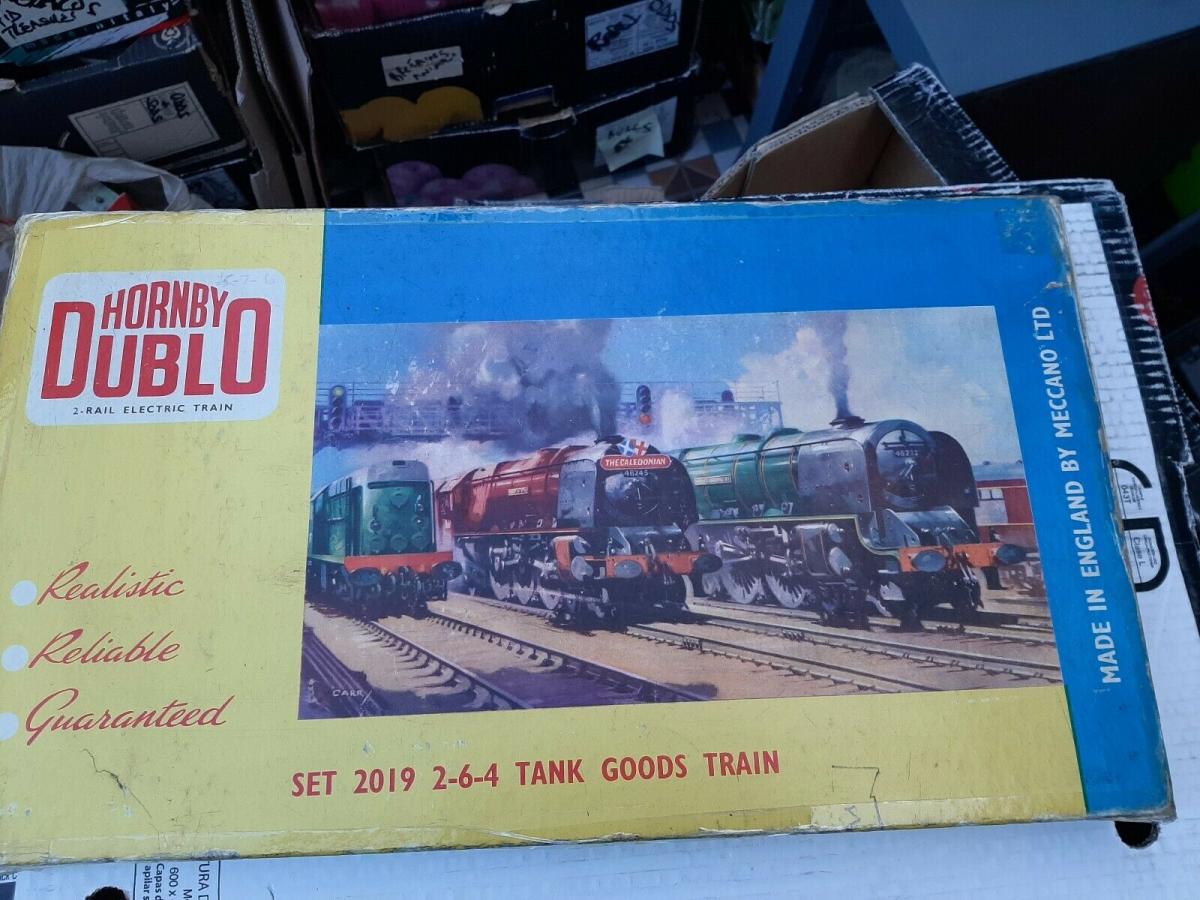
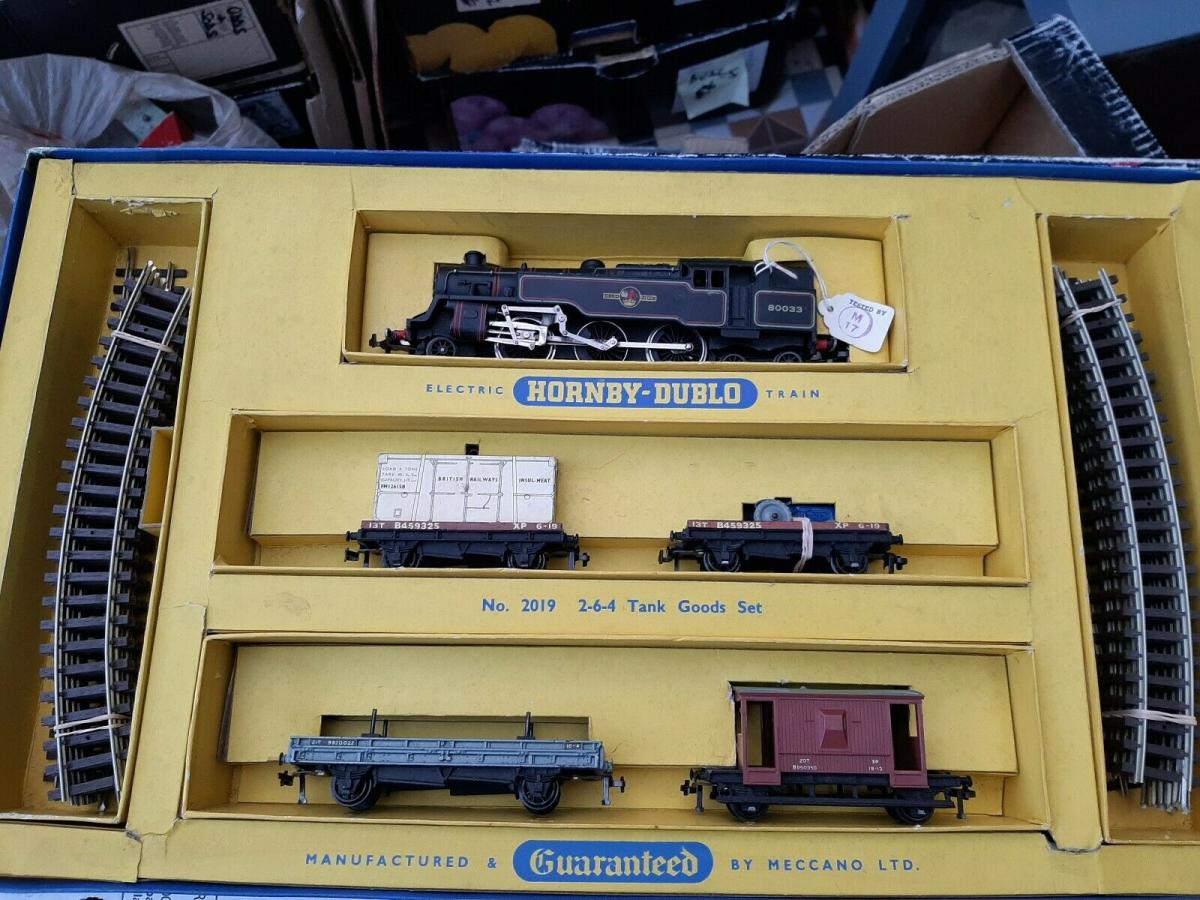
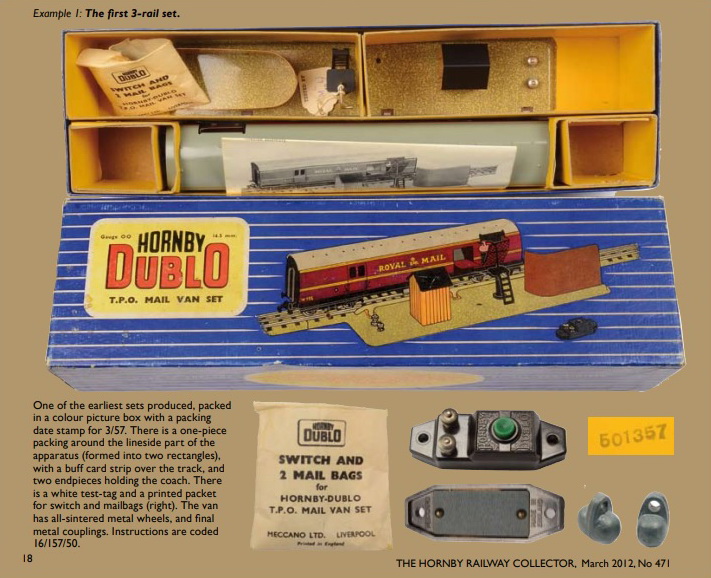
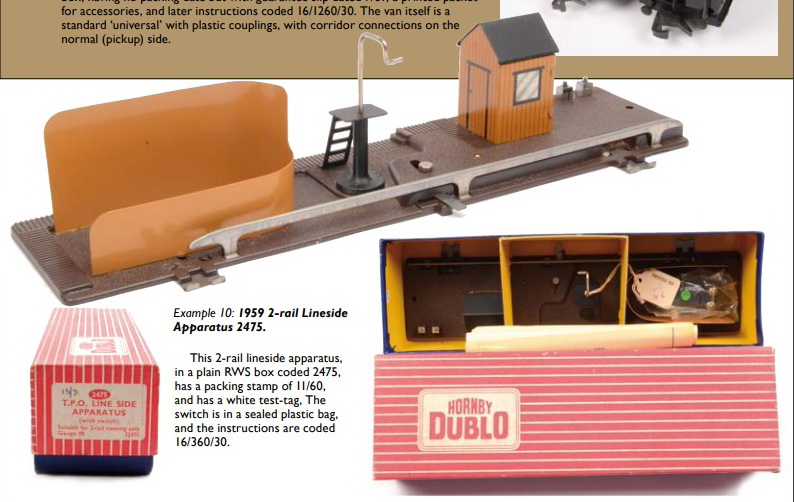
-914 AEC Articulated Lorry (1965-70)
-163 Bristol 450 Sports Coupé (1956-60)
-163 Bristol 450 Sports Coupé (1956-60)
-914 AEC Articulated Lorry (1965-70)
DTCAwebsite upgrade 2023
DTCAwebsite upgrade 2023
DTCAwebsite upgrade 2023
DTCAwebsite upgrade 2023
DTCAwebsite upgrade 2023
DTCAwebsite upgrade 2023
-508 DAF
--14c and 401Coventry Climax Fork Lift Truck (1949-64)
FRENCH DINKY TALBOT LAGO
-Boxes General Discussions including end flaps, both British and French
--14c and 401Coventry Climax Fork Lift Truck (1949-64)
--14c and 401Coventry Climax Fork Lift Truck (1949-64)
-508 DAF
DTCAwebsite upgrade 2023
DTCAwebsite upgrade 2023
DTCAwebsite upgrade 2023
DTCAwebsite upgrade 2023
DTCAwebsite upgrade 2023
-508 DAF
-508 DAF
-508 DAF
New arrivals
New arrivals
DTCAwebsite upgrade 2023
DTCAwebsite upgrade 2023
ORIGINAL MECCANO DINKY TOYS FACTORY BOX ART 175 HILLMAN MINX SALOON + DRAWING
--29c and 290 Double Decker Bus (1938-63)
DTCAwebsite upgrade 2023
DTCAwebsite upgrade 2023
DTCAwebsite upgrade 2023
DTCAwebsite upgrade 2023